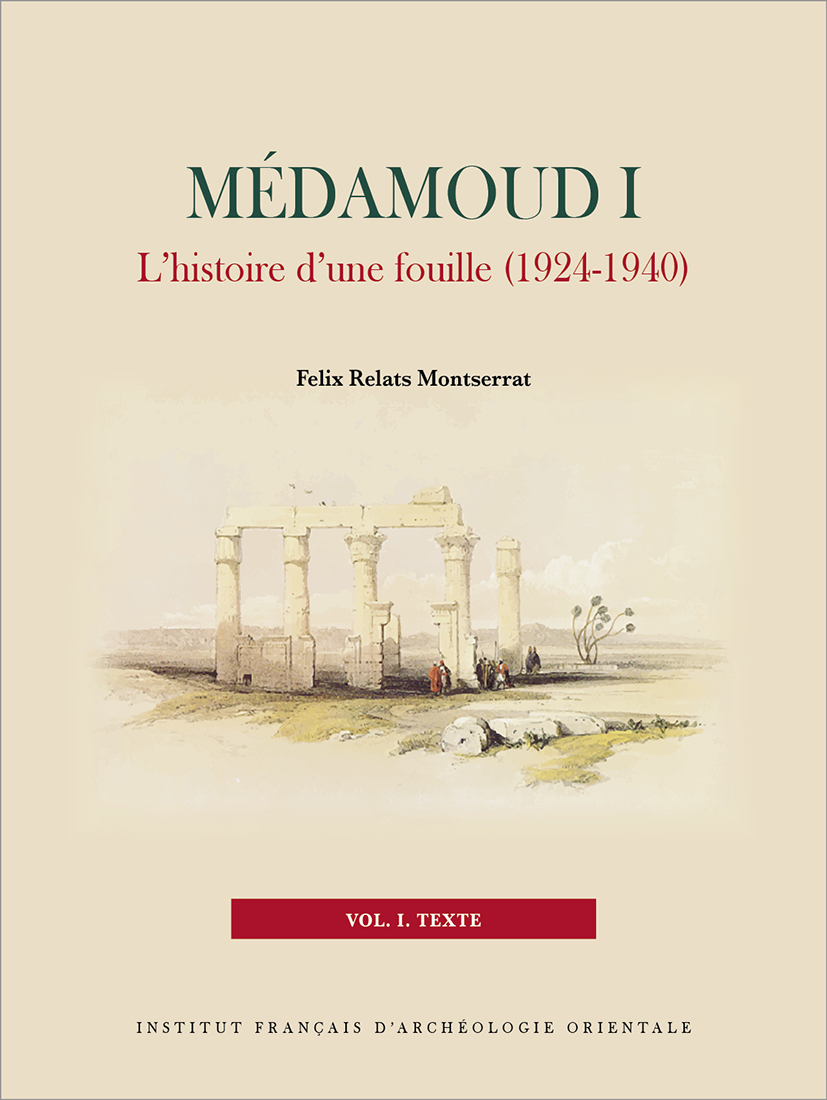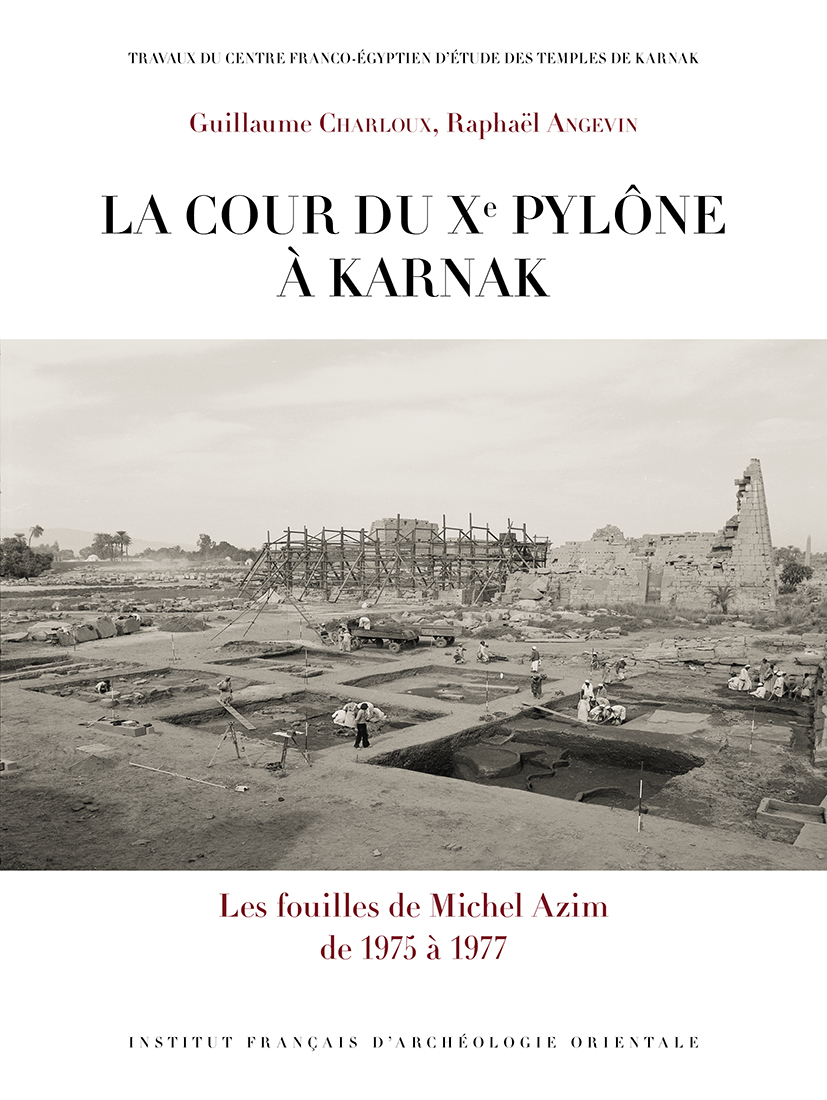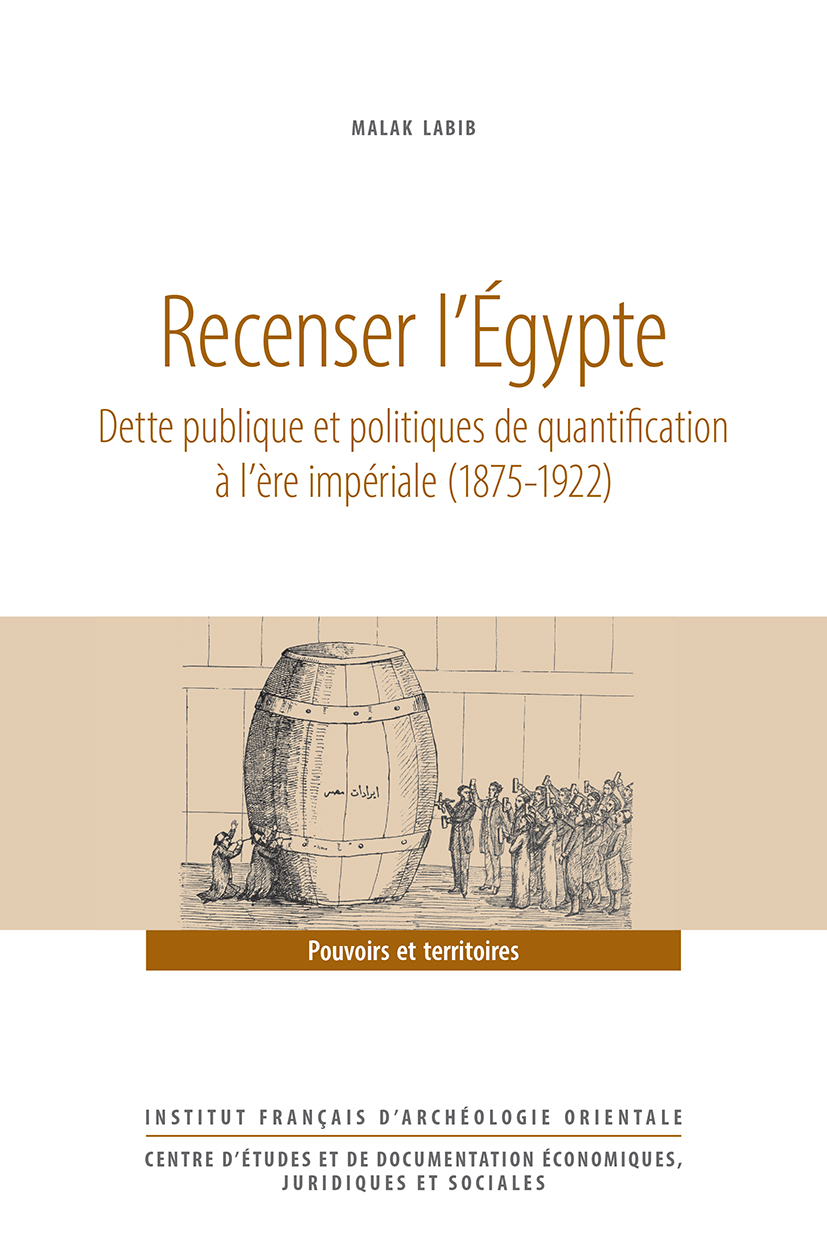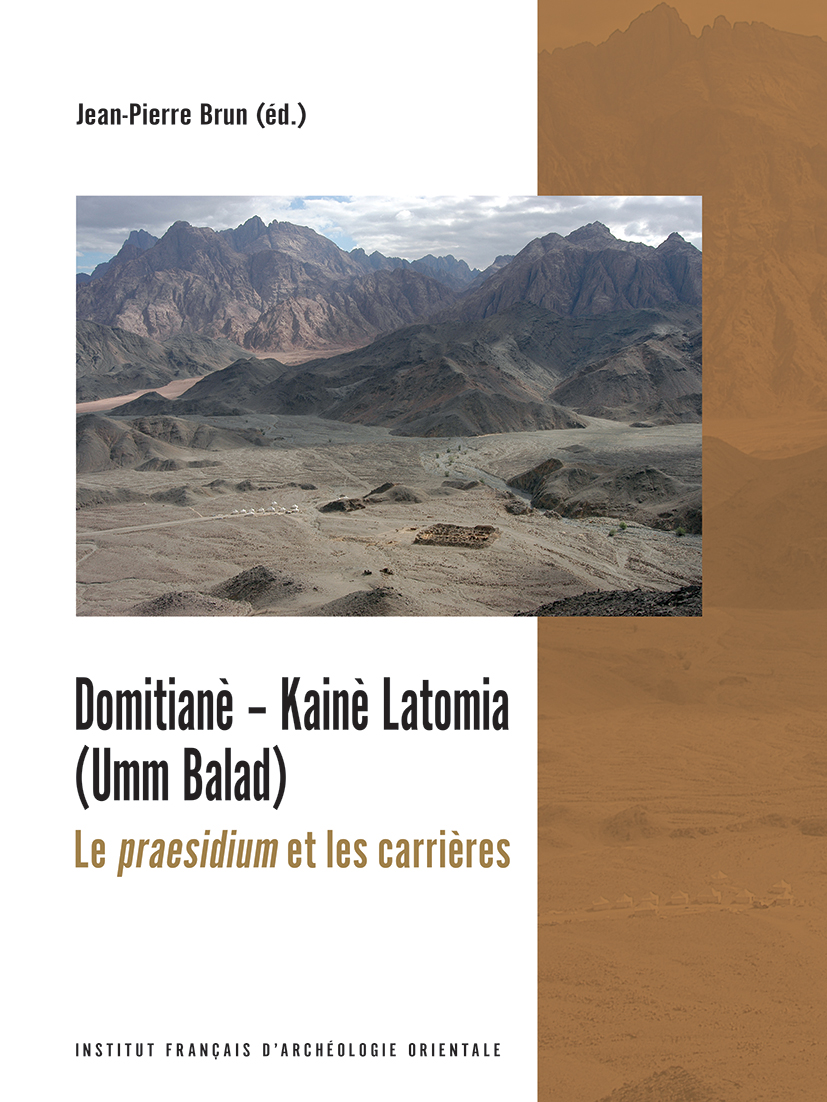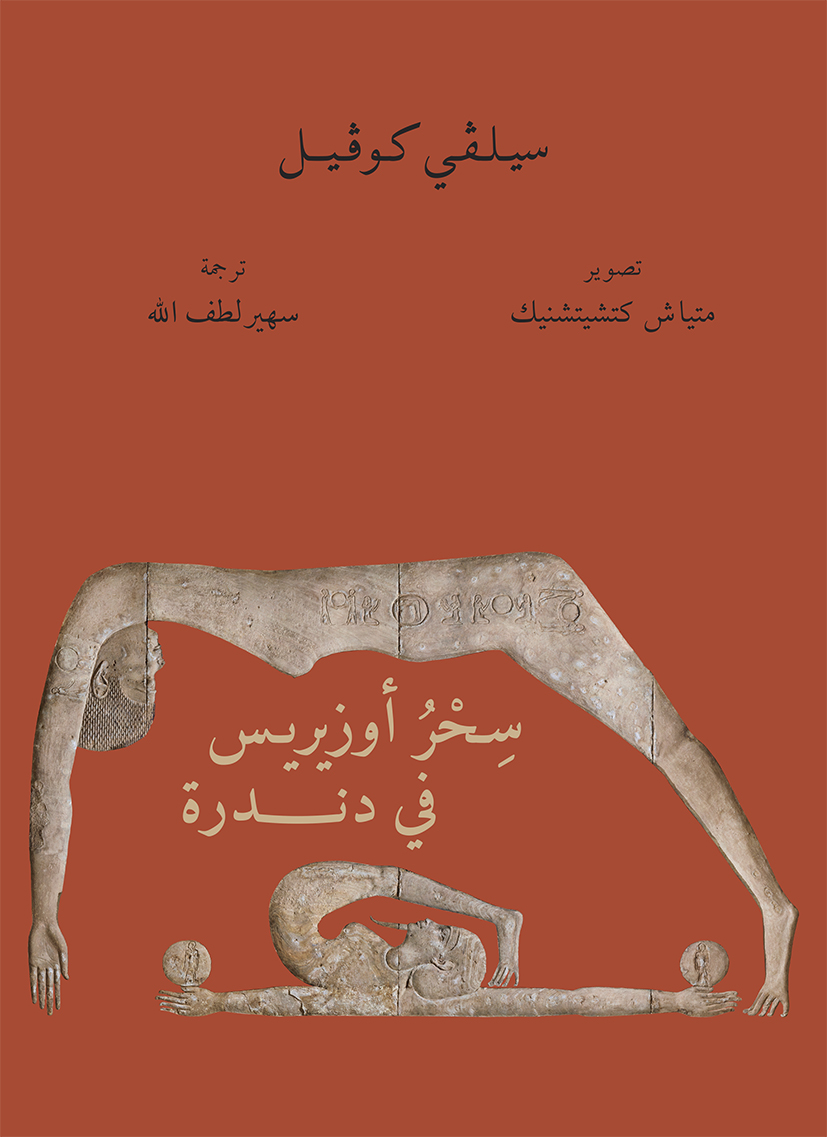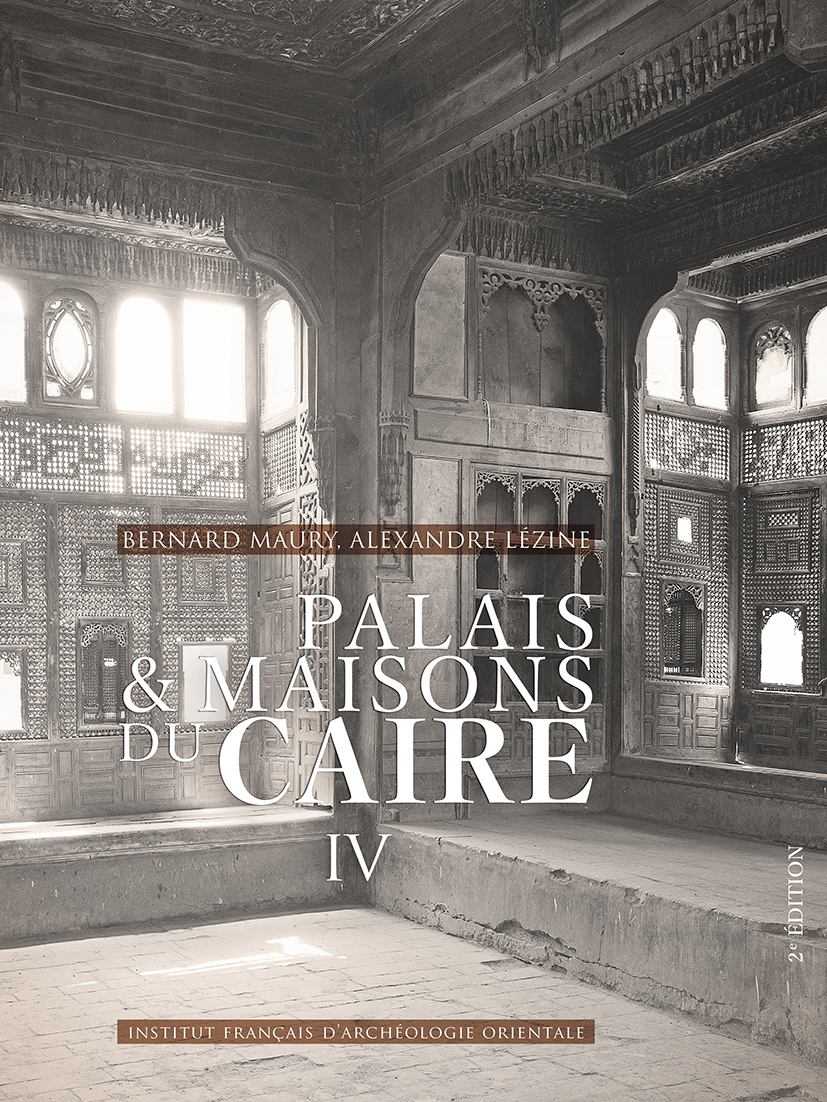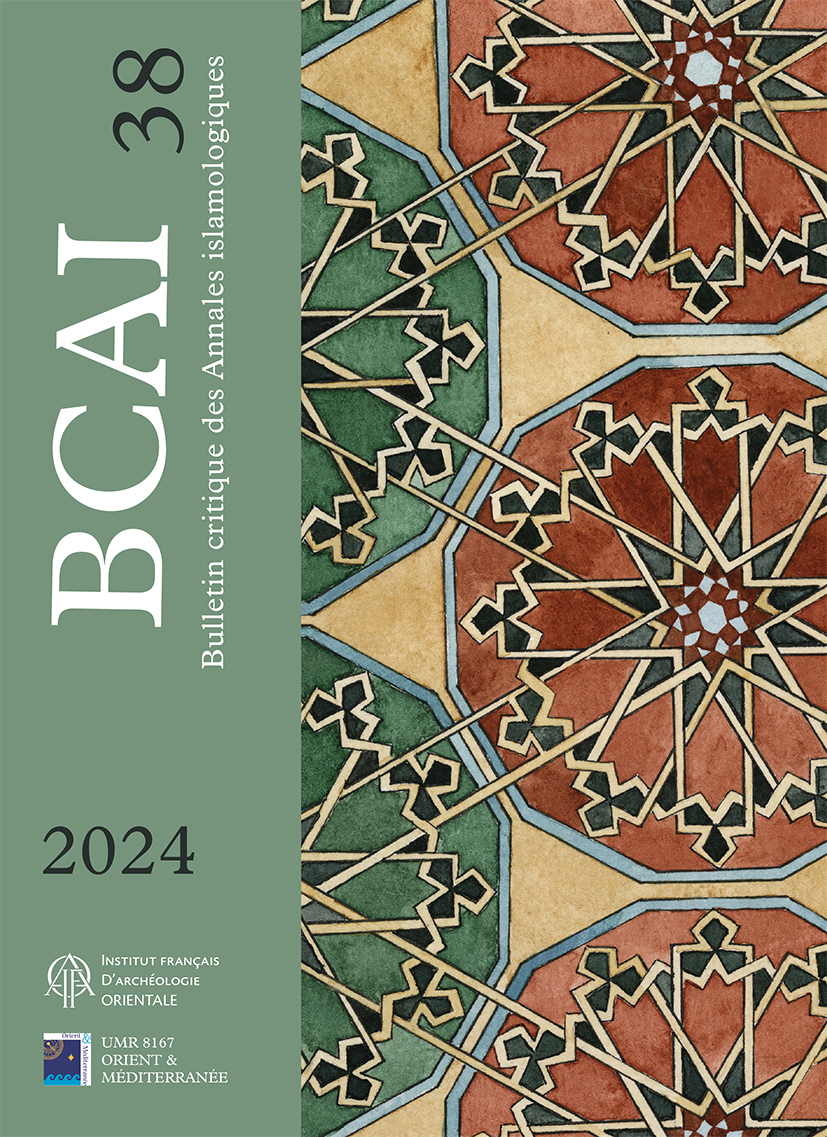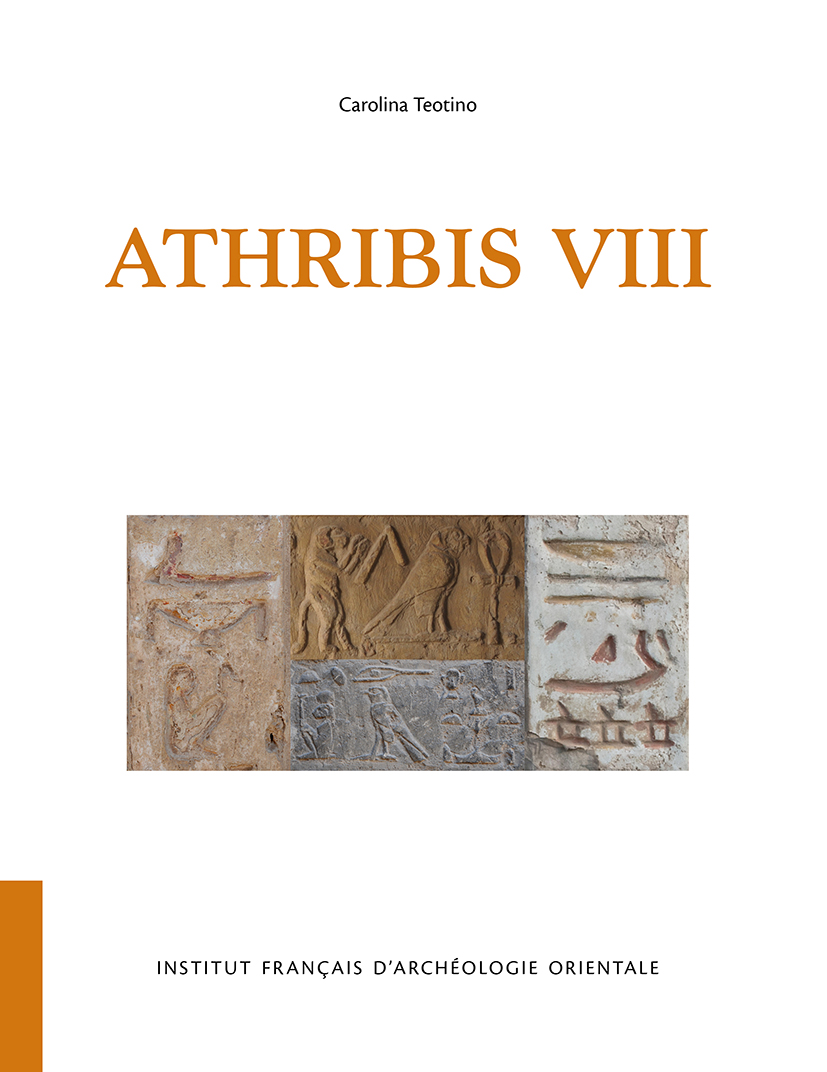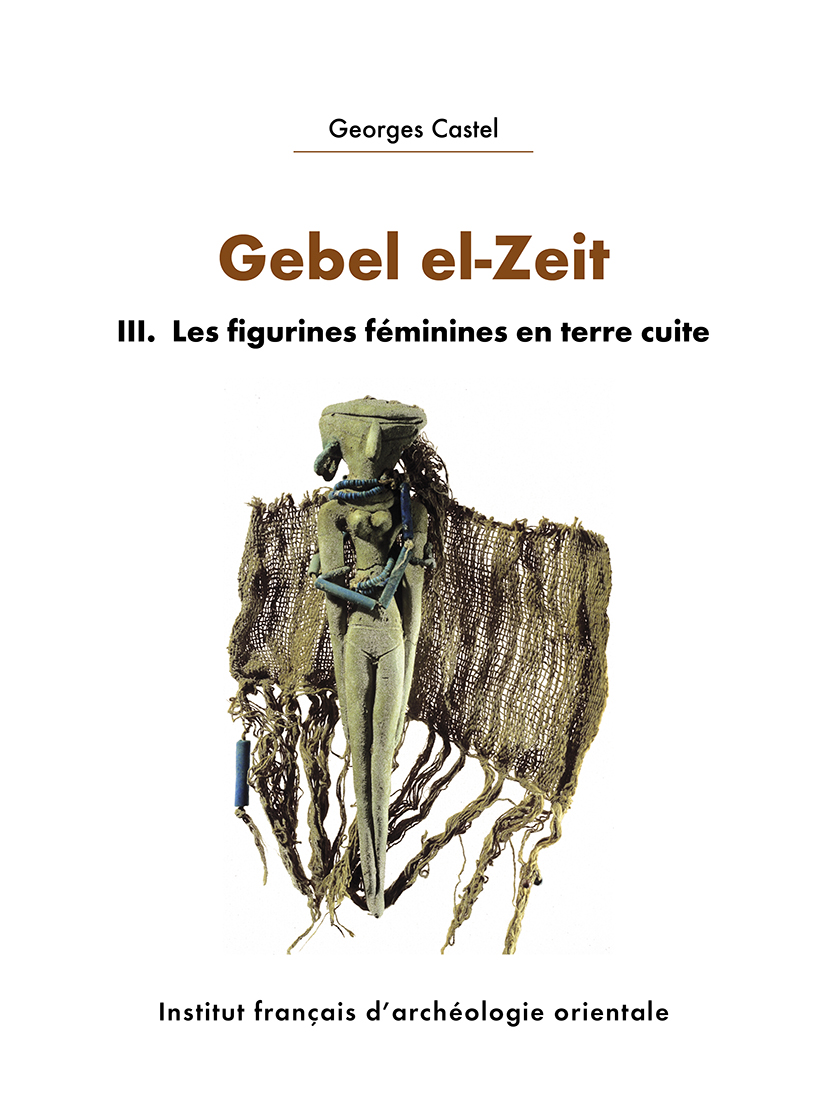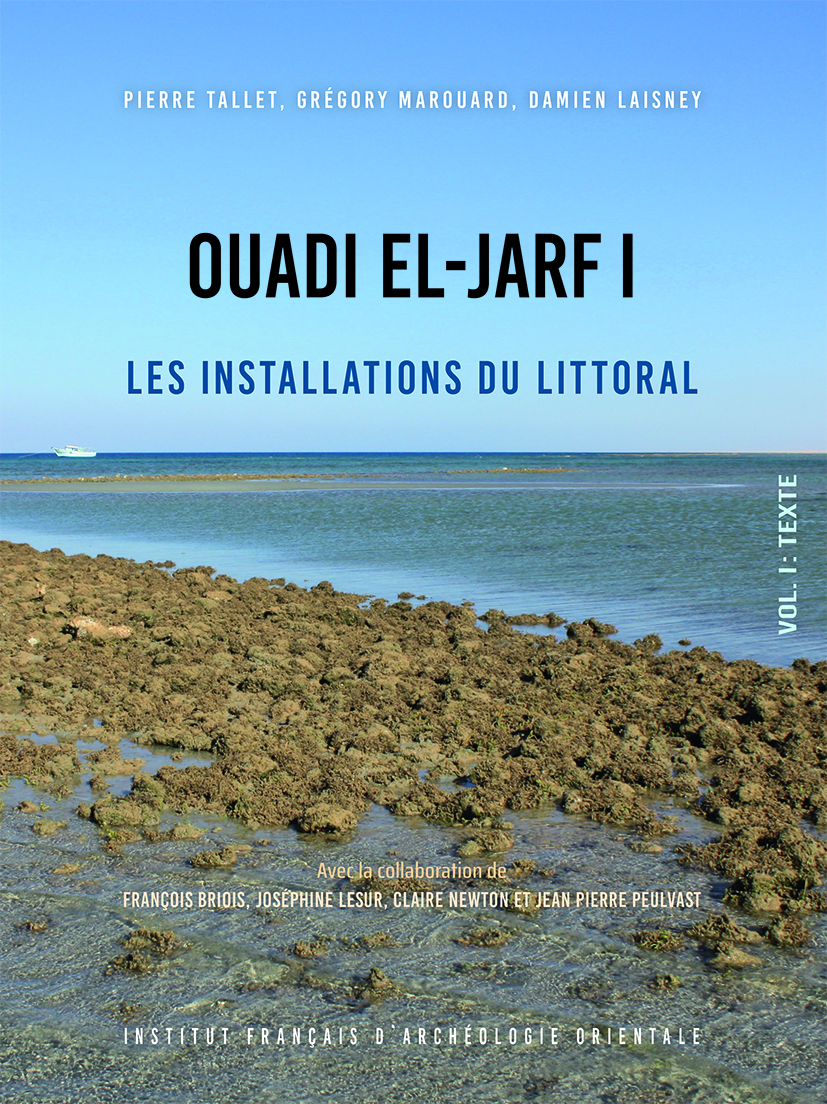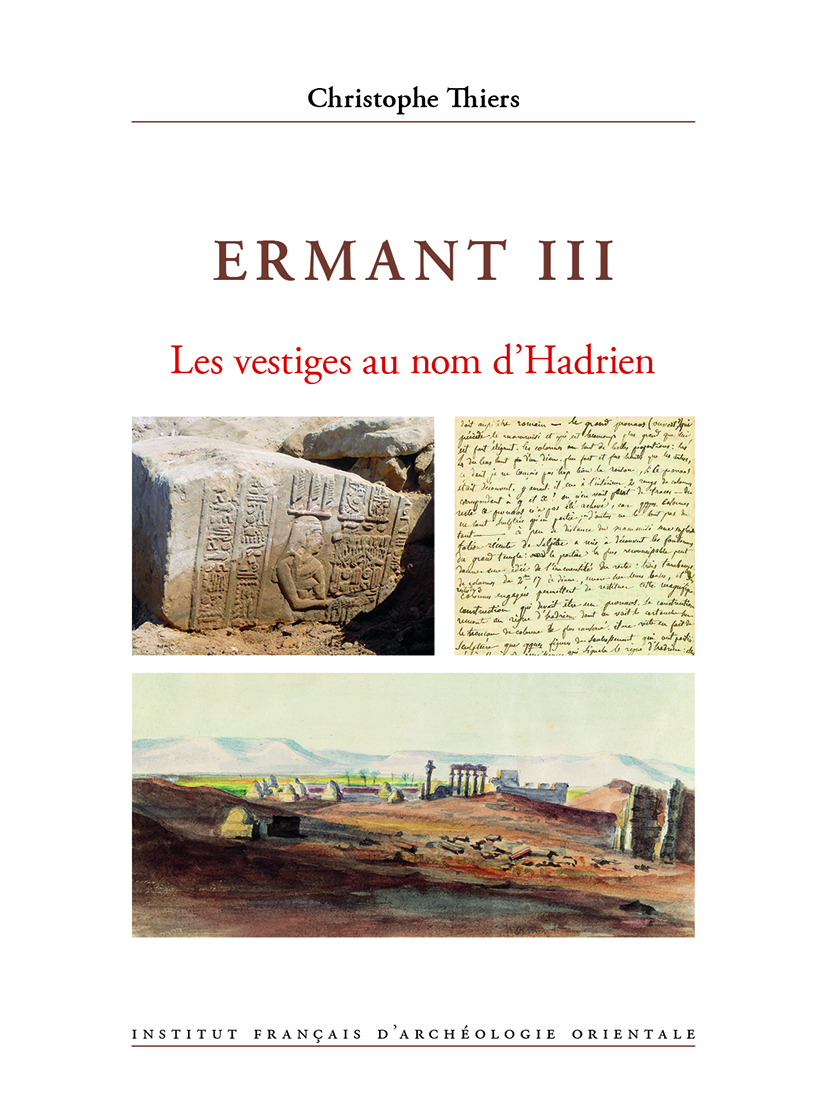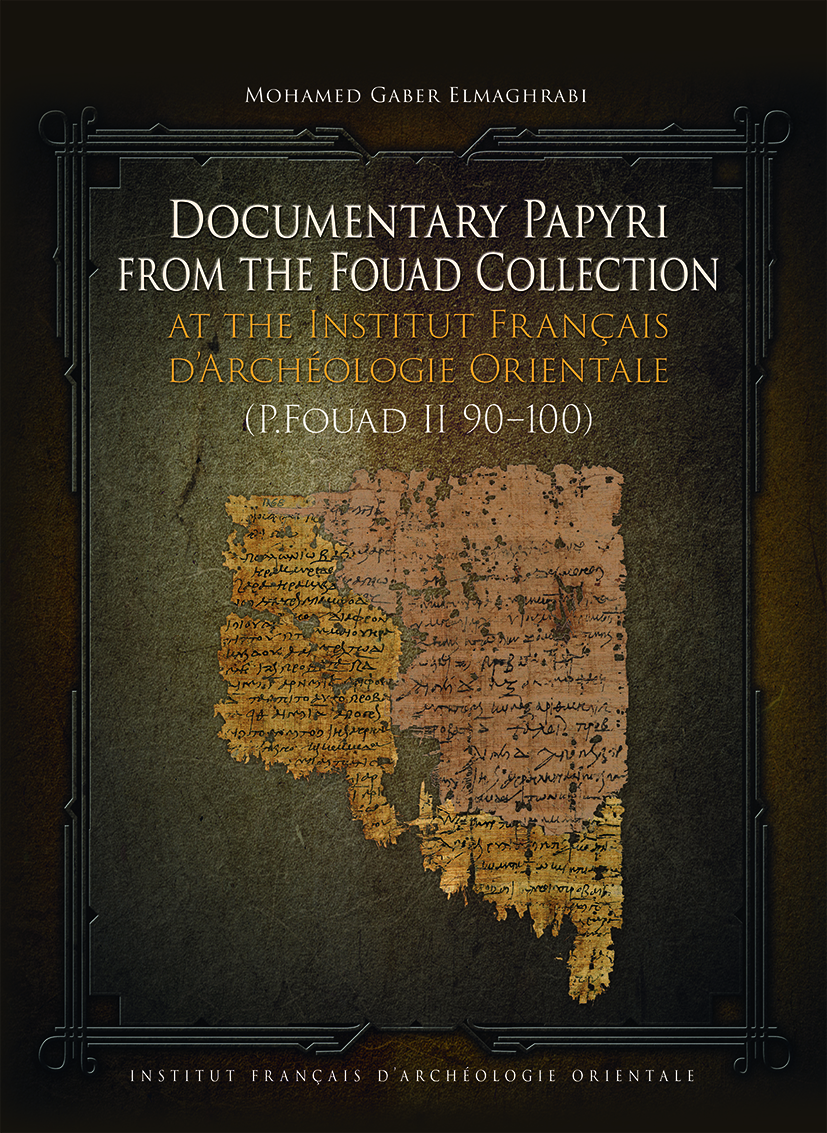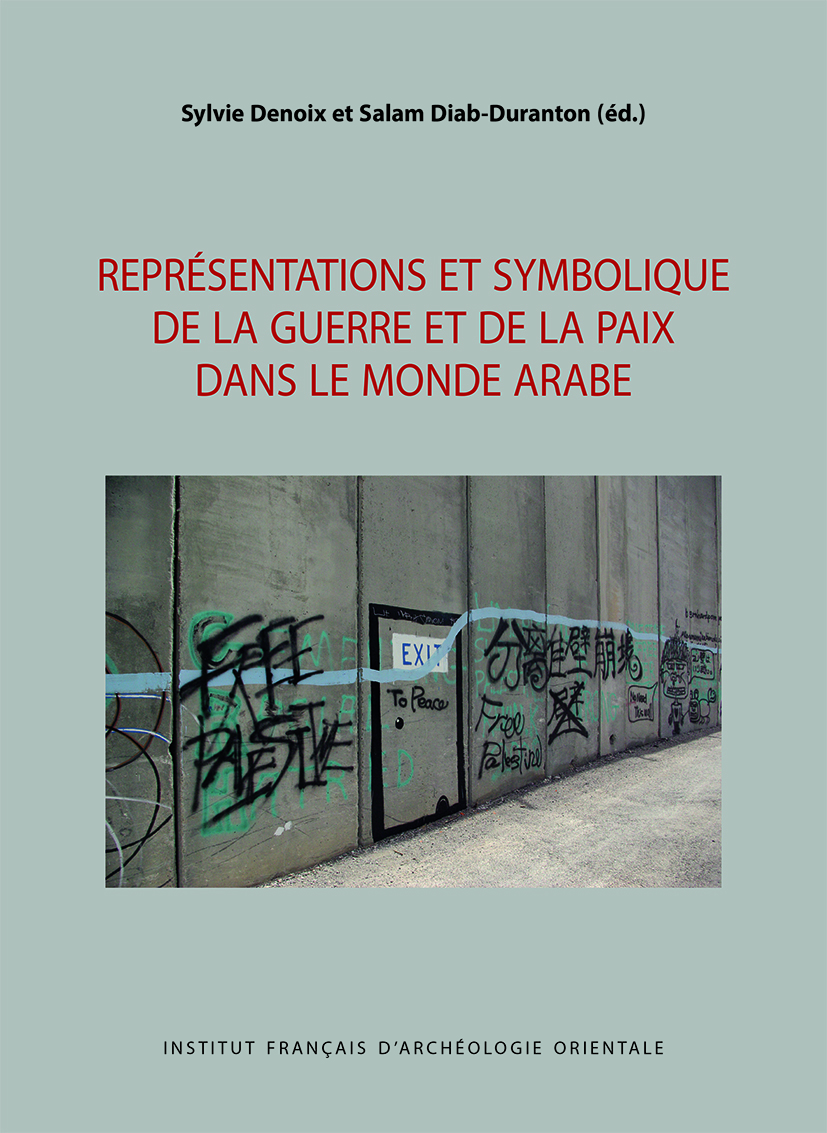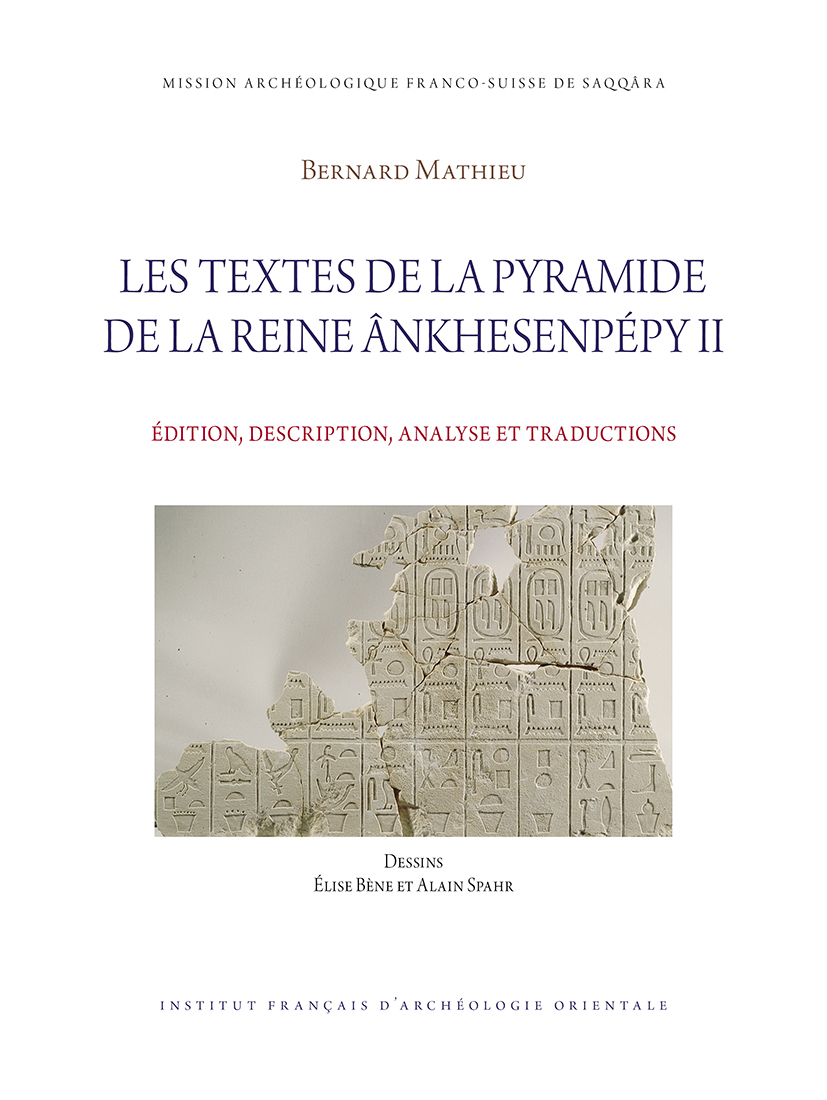Catalogue des publications
- Pour effectuer une commande, remplissez votre panier puis terminez votre commande. Vous pourrez effectuer un paiement sécurisé et être livré dans le monde entier. J’ai un code promotionnel
- To perform an order, fill your cart then proceed the order. You will be driven to a secured page for the electronic payment which includes worldwide shipping fees. I have a promotional code.
Nouveautés 2024
Felix Relats Montserrat
Médamoud I
L'histoire d'une fouille (1924-1940)
Les fouilles françaises de Médamoud se sont déroulées entre 1924 et 1939 sous la direction de F. Bisson de la Roque (1924-1932) et de Cl. Robichon (1933-1939). Elles mirent au jour de nombreux monuments s’échelonnant de la XIe dynastie jusqu’à l’époque byzantine. L’ensemble de cette documentation constitue un corpus riche mais hétérogène dont il a fallu restituer le contexte de découverte, d’autant que les fouilles ont été inégalement publiées. Dans cette optique, il s’est avéré nécessaire, en premier lieu, d’inventorier les vestiges afin de préciser leur datation, leur interprétation et la manière dont ils furent dégagés au début du XXe siècle. Or, l’analyse de l’exploration d’un site, si elle documente les découvertes archéologiques réalisées, livre tout autant d’informations sur le contexte de l’époque où elles ont eu lieu, à la fois sur le plan intellectuel, technique et politique. De là découle le second objectif de l’ouvrage, Médamoud offrant un cas d’étude pour comprendre la manière dont était organisée une mission archéologique, aussi bien du point de vue pratique, que sous l’angle administratif, au début du XXe siècle. Le présent ouvrage est donc organisé en deux parties, présentant d’abord un historique de l’exploration du site, puis un inventaire des structures découvertes.
The French excavations at Medamud took place between 1924 and 1939 under the direction of F. Bisson de la Roque (1924-1932) and Cl. Robichon (1933-1939). They uncovered numerous monuments ranging in date from the 11th Dynasty to the Byzantine period. All of the documentation constitutes a rich but heterogeneous corpus. However, since the publication of the excavations was uneven, it has been necessary to recreate the process of discovery. In order to understand the context in which the architectural remains were found at the beginning of the 20th century, they were inventoried while verifying their dating and interpretation. Since the analysis of the exploration of a site that documents the archaeological discoveries also yields information about the intellectual, technical, and political context of the period in which it took place, this book also presents Medamud as a case study for understanding how an archaeological mission was organized, both practically and administratively, at the beginning of the 20th century. The present work is thus organized in two parts, first presenting a history of the exploration of the site, then an inventory of the structures discovered.
جرت الحفائر الفرنسيَّة في مدامود في الفترة من ١٩٢٤م وحتى ١٩٣٩م تحت إشراف F. Bisson de la Roque (١٩٢٤-١٩٣٢م) وCl. Robichon(١٩٣٣-١٩٣٩م) حيث تم اكتشاف العديدَ مِنَ الآثارِ التي تتراوح من عصر الأسرة الحادية عشرة إلى العصر البيزنطي. تُشكّل كل هذه المكتشفات مجموعةً ثرية، ولكن غير مُتجانسة، فكان لا بد من العودة إلى الظروف التي اكتشفت فيها، خاصة أن عمليات التّنقيب لم يتم نشرها بالتساوٍي. ومن هذا المنطلق، كان لا بد أوَّلًا من القيام بحصر الآثار لتحديد تأريخها وتفسيرها والطريقة التي تم استخراجها بها في بداية القرن العشرين. ومع ذلك، فإن تحليل استكشاف موقع ما، إذا كان يوثّق الاكتشافات الأثريَّة التي تمّت، يوفّر نفسَ القدرِ مِنَ المعلومات حول الفترة التي حدثت فيها، فكريًا وتقنيًا وسياسيًا. ومن هنا ينبع الهدف التالي لهذا الكتاب "مدامود" الذي يقدم نموذج دراسة لفهم كيفية تنظيم البعثة الأثريَّة، عمليًا وإداريًا، في بداية القرن العشرين. ولذلك، تمَّ تنظيم العمل الحالي في جزئين، يقدم الأوَّل منهما تاريخ استكشاف الموقع، ويقدم الثاني جرد للمباني المُكتشفة.
- Felix Relats Montserrat (
: 196934559)
Agrégé d’histoire, docteur en égyptologie de l’université de Paris-Sorbonne, membre scientifique de l’Institut Français d’Archéologie Orientale du Caire entre 2017 et 2021. Ses recherches portent sur les relations nouées entre le pouvoir royal et les temples, ainsi que sur l’insertion de ces derniers dans leur environnement urbain. Il s’intéresse également à l’artisanat égyptien et tout particulièrement à la production de céramiques. En parallèle, ses recherches doctorales l’ont amené à développer une réflexion sur l’histoire de l’égyptologie au début du XXe siècle. Il dirige la mission Ifao / Sorbonne de Médamoud avec le soutien de la commission des fouilles du MEAE (Louqsor).
- Vous pouvez acquérir ce(s) fichier(s) PDF issu(s) de cet ouvrage en cliquant sur le nom du fichier puis 'Ajouter au panier'.
- You can buy theses PDF files extracted from this book by clicking on the file name then 'Add to cart'.
ISBN 9782724710151
2024 IFAO
Collection: FIFAO 95
Langue(s): français
1 vol. 305 p.
50 € (2500 EGP)
Béatrix Midant-Reynes (éd.), Nathalie Buchez (éd.)
Tell el-Iswid – 2010-2018
Les occupations naqadiennes du secteur 4
Ce second volume des fouilles de Tell el-Iswid est consacré aux vestiges naqadiens du secteur 4. Il s’agit d’un bâti de briques crues, couvrant essentiellement la période Naqada IIIA-B. Trois phases de transformations majeures ont été décelées. La mieux représentée est la phase 2 dont le bâti a été plusieurs fois remanié. Une attention particulière a été accordée aux structures de combustion.
À ces transformations architecturales répondent des changements dans la culture matérielle (céramique, industrie lithique, petit mobilier) en lien avec les données relatives à l’économie de subsistance (faune et micro-restes végétaux).
La céramique, en particulier, a été étudiée selon des approches nouvelles, où les classifications sont fondées prioritairement sur les techniques de fabrication et la restitution des chaînes opératoires, ce qui permet de mieux appréhender les identités culturelles et de dépasser les visées essentiellement chronologiques des classifications morpho-stylistiques traditionnelles.
Les travaux ici présentés prennent place dans le renouvellement des données apportées par les fouilles du site voisin de Tell el-Farkha et par celles de Bouto dans le delta occidental. Ils contribuent à jeter, depuis le Delta, un nouvel éclairage sur les transformations socio-culturelles qui ont affecté l’ensemble de la Vallée du Nil dans le dernier tiers du IVe millénaire.
This second volume of the Tell el-Iswid excavations is devoted to the Naqada period remains in sector 4. It concerns a mud-brick building, dating essentially to the Naqada III A-B period. Three major phases of transformation were detected. The best represented is phase 2, which was reworked several times. Particular attention was paid to the structures which were burned.
These architectural transformations are mirrored by changes in material culture (ceramics, lithic industry, small finds) in connection with data relating to the subsistence economy (fauna and plant micro-remains).
Ceramics have been studied according to new approaches, in which classifications are based primarily on manufacturing techniques and the reconstruction of the « chaîne opératoire », which makes it possible to better understand cultural identities and to go beyond the essentially chronological aims of traditional morpho-stylistic classifications.
The work presented here is part of the review of data from excavations at the neighboring site of Tell el-Farkha and at Bouto in the western Delta. They contribute to shedding new light from the Delta on the socio-cultural transformations that affected the whole Nile valley in the last third of the 4th millennium BC.
يخصص هذا المجلد الثاني من حفائر تل الأسود للبقايا الأثرية لموقع نّقادة في القطاع رقم ٤. ويتعلق بمبنى من الطوب اللبن، يعود تاريخه بشكلٍ أساسي إلى فترة نقادة الثالثة «أ-ب» (IIIA-B). وقد تمَّ الكشف عن ثلاث مراحل رئيسية من التّحوّل. أفضل مرحلة مُمثَّلة هي المرحلة رقم ٢، والتي تمَّ إعادة عملها عِدَّة مرّات. وقد وجه اهتمام خاص بالمباني الخاصة بالحرق.
تتواءم هذه التّحوّلات المعماريَّة مع تّغيُّرات في الثّقافة الماديّة (الفخار، الصِّناعة الحجريَّة، اللُقى الصّغيرة) فيما يتعلق بالبيانات المتعلقة بـ «اقتصاد الكفاف» (البقايا الدّقيقة للحيوانات والنباتات).
وقد تمَّت دراسة الفخار، على وجه الخصوص، وفقًا لمُقاربات جديدة، حيث تعتمد التصنيفات المستخدمة في المقامِ الأوَّل على تقنيات التّصنيع واستعادة سلسلة التّشغيل، مِمَّا يتيح فهم الهويّات الثّقافيَّة بشكلٍ أفضل وتجاوز الأهداف التّأريخية الأساسية للتصنيفات المورفولوجيّة الأسلوبيّة التقليديّة.
يقع العمل المعروض هنا ضمن تحديث البيانات التي أتاحتها أعمال التنقيب في موقع «تل الفرخة» المجاور لموقع تل الأسود، وتلك الموجودة في بوتو في الدلتا الغربيَّة. وتسهم في تسليط ضوءٍ جديد على التَّحوّلات الاجتماعيَّة والثّقافيَّة في الدلتا والتي أثّرت على وادي النيل كله في الثُّلث الأخير من الألفيّة الرابعة قبل الميلاد.
- Béatrix Midant-Reynes (
: 030156963)
Béatrix Midant-Reynes s’est spécialisée dans l’étude de la préhistoire égyptienne. Elle a dirigé, dans le cadre de l’Ifao, plusieurs chantiers de fouilles en Égypte, tous centrés sur la période prédynastique : Adaïma, en Haute Égypte (nécropoles et habitat), Kom el-Khilgan, dans le Delta oriental (nécropole), Tell el-Iswid, dans le Delta oriental (habitat). En 2015, elle a transmis la direction de la fouille de ce site à Nathalie Buchez. De 2000 à 2015, elle a codirigé le volet préhistoire du programme de prospection du bassin sud de Douch (oasis de Kharga). De 2010 à 2015, elle a été directrice de l’Institut français d’archéologie orientale. Elle est actuellement directrice de recherche émérite au CNRS. Parmi les ouvrages publiés, deux sont adressés à un plus large public : Prehistory of Egypt, From the First Egyptians to the First Pharaohs, Londres, 2000, et Aux origines de l’Égypte. Du Néolithique à l’émergence de l’État, Paris, 2003. - Nathalie Buchez (
: 066514290)
Nathalie Buchez est responsable de recherche archéologique à l’Institut national de recherche en archéologie préventive (Inrap) où elle est plus particulièrement en charge d’opérations de terrain, d’études céramiques et de coordination de projets concernant les âges du Bronze et du premier âge du Fer dans le nord de la France. Docteure en archéologie de l’EHESS, rattachée à l’UMR 5608-TRACES de Toulouse, elle poursuit des recherches sur l’Egypte prédynastique depuis 1989. En 2015, elle a succédé à Béatrix Midant-Reynes comme responsable de la fouille de Tell el-Iswid (Delta oriental) pour l’Ifao et le ministère de l’Europe et des Affaires étrangères.
- Vous pouvez acquérir ce(s) fichier(s) PDF issu(s) de cet ouvrage en cliquant sur le nom du fichier puis 'Ajouter au panier'.
- You can buy theses PDF files extracted from this book by clicking on the file name then 'Add to cart'.
ISBN 9782724710205
2024 IFAO
Collection: BiEtud 187
Langue(s): allemand
1 vol. 414 p.
gratuit - free of charge
la version papier n’est pas disponible
Christian Leitz (éd.)
Kurzbibliographie zu den übersetzten Tempeltexten der griechisch-römischen Zeit, 7e éd.
Ce livre fait suite à l’ouvrage de Jean-Claude Grenier : Temples ptolémaïques et romains. Répertoire bibliographique (index des citations 1955-1974, incluant l’index des citations de 1939 à 1954 réunies par N. Sauneron), BiEtud 75, Le Caire, 1979. Afin d'offrir au chercheur un outil d’actualité, il est dorénavant disponible sur le site de l’Ifao (www.ifao.egnet.net) et régulièrement mis à jour sous la responsabilité de Christian Leitz.
This book updates Jean-Claude Grenier’s Temples ptolémaïques et romains. Répertoire bibliographique : Index des citations 1955-1974, incluant l’index des citations de 1939 à 1954 réunies par N. Sauneron, BiEtud 75, Cairo, 1979. In order to provide scholars with an ever-relevant research tool, the bibliography is available on the IFAO website (www.ifao.egnet.net), with regular updates reviewed by Christian Leitz.
- Christian Leitz (
: 070209448)
Christian Leitz est professeur d’égyptologie à Tübingen (depuis 2004). Il a été professeur invité à l’École Pratique des Hautes Études, Paris (2007), au Collège de France (2009), à l’université du Caire (2013).
ISBN 9782724710113
2024 IFAO
Collection: BiGen 75
Langue(s): français
1 vol. 248 p.
33 € (1650 EGP)
Guillaume Charloux (éd.), Raphaël Angevin (éd.)
La cour du Xe pylône à Karnak
Les fouilles de Michel Azim de 1975 à 1977
Au milieu des années 1970, la fouille engagée par l’architecte Michel Azim dans la cour du Xe pylône constituait l’une des premières explorations archéologiques d’ampleur entreprises à l’emplacement de l’allée processionnelle sud-nord du grand temple d’Amon-Rê depuis les travaux de Georges Legrain au début du xxe siècle. En dépit de son importance, cette opération est demeurée largement inédite et les résultats des travaux réalisés n’ont jusqu’ici fait l’objet que de rares notes liminaires.
Le présent ouvrage vient conclure un ambitieux programme d’inventaire de la documentation de ces fouilles conservée dans plusieurs institutions françaises et égyptiennes. L’ensemble des résultats obtenus à l’issue des campagnes de recherche de 1975-1976 et 1977 est ici réexaminé à la lumière d’un sondage d’évaluation stratigraphique effectué en 2015, dont le mobilier archéologique est analysé par une dizaine de spécialistes.
Bien que la séquence des constructions et des occupations de la cour du Xe pylône reste très proche de celle restituée initialement par le fouilleur, les analyses récentes permettent de réviser en profondeur la chronologie du site, et se révèlent essentielles pour la connaissance de l’histoire urbaine de Thèbes.
In the mid-1970s, Michel Azim, architect at the Franco-Egyptian Center for the Study of the Temples of Karnak, undertook the first large-scale archaeological investigation in the courtyard of the 10th pylon since the work of Georges Legrain at the beginning of the 20th century. Despite its importance, however, this operation has remained largely unpublished and the results of the work carried out have been the subject of only a few preliminary reports and notes.
The present book concludes an ambitious program of inventorying the documentation of these excavations stored in several French and Egyptian institutions. All the results of the research carried out from 1975 to 1977 are re-examined here in the light of a stratigraphic evaluation test-pit undertaken in 2015—the archaeological material from which is analyzed by a dozen specialists.
Although the sequence of constructions and occupations of the 10th pylon courtyard remains very close to the one initially established by the excavator, the recent analyses make it possible to more precisely calibrate the chronology of the site, and will thus prove essential for the study of Ancient Thebes.
تُعد الحفائر التي قام بها المهندس المعماري ميشيل عظيم في منتصف سبعينيات القرن الماضي، في فناء الصرح العاشر هي أوَّلِ حفائر أثريَّة واسعة النّطاق أُجريت في موقع الممر الاحتفالي المتجه جنوب-شمال بمعبد آمون رع الكبير وذلك منذ أعمال Georges Legrain في بداية القرن العشرين. ولكن على الرغم من أهمّيَّة هذه الحفائر، إلا أنها لم تنشر بشكل كامل وأشير إلى نتائج العمل المُنجز بتقارير أولية بسيطة فقط.
الكتاب الحالي ينهي برنامجًٍا طموحًا لجرد توثيق هذه الحفائر المحفوظة في العديدِ من المؤسَّسات الفرنسيَّة والمصريَّة. حيث تتم هنا إعادة فحص جميع نتائج الدراسات التي أُجريت في ١٩٧٥-١٩٧٦م و١٩٧٧م، في ضوء تقييم المسح الأثري للطبقات الذي أُجري في عام ٢٠١٥، والتي قام عشرات من المتخصصين بتحليل البقايا الأثريَّة منها.
وعلى الرغم من أنَّ التتابع الزمني للمنشآت وإشغالات فناء الصّرح العاشر تظلّ قريبة جدًا من تلك التي حدَّدها المُنقِّب في البداية، إلَّا أنَّ التّحاليل الحديثة تتيح مراجعة متعمقة للتّسلسل الزّمني للموقع، وبالتالي تُثبت أنَّها ضرورية لمعرفة تاريخ مدينة طيبة.
- Guillaume Charloux (
: 109153634)
Guillaume Charloux, docteur en archéologie de l’université Paris 1 Panthéon-Sorbonne, diplômé de l’École du Louvre et de l’École biblique et archéologique française de Jérusalem, est actuellement ingénieur de recherche au CNRS (UMR 8167, Orient & Méditerranée, Paris). Il dirige depuis 2010 la mission archéologique et épigraphique Oasis de l’Arabie déserte, regroupant plusieurs sites majeurs d'Arabie : al-Bad', Camel Site, Dûmat al-Jandal, Kharj et Najrân. Il coordonne également plusieurs projets de recherche à Karnak (Égypte), auprès du CFEETK (USR 3172 du CNRS - CSA), notamment la fouille du temple de Ptah en collaboration avec Christophe Thiers (CNRS, UMR5140), et la publication des fouilles archéologiques 1975-1977 de la cour du Xe pylône avec Raphaël Angevin (Ministère de la culture, UMR 7041, Arscan). - Raphaël Angevin (
: 167355201)
Raphaël Angevin est préhistorien et archéologue. Conservateur du patrimoine au Service régional de l’archéologie d’Auvergne-Rhône-Alpes, il est spécialiste des industries lithiques du Chalcolithique et de l’âge du Bronze au Proche-Orient. Ses travaux l’ont notamment conduit à rouvrir le dossier des origines de Karnak et à examiner le mobilier lithique provenant des fouilles anciennes et récentes sur le site. Membre du laboratoire VEPMO de l’UMR 7041-ArScAn et doctorant de l’université de Paris 1 Panthéon-Sorbonne, il consacre sa thèse à l’étude technologique des productions en silex et en obsidienne du site de Mari (Tell Hariri, Syrie) et à leur relation avec les systèmes techniques mésopotamiens des IVe et IIIe millénaires.
- Vous pouvez acquérir ce(s) fichier(s) PDF issu(s) de cet ouvrage en cliquant sur le nom du fichier puis 'Ajouter au panier'.
- You can buy theses PDF files extracted from this book by clicking on the file name then 'Add to cart'.
ISBN 9782724710168
2024 IFAO
Collection: RAPH 47
Langue(s): français
1 vol. 232 p.
13 € (650 EGP)
Malak Labib
Recenser l’Égypte
Dette publique et politiques de quantification à l’ère impériale (1875-1922)
Dans la décennie qui précède l’occupation britannique (1882), l’Égypte est placée sous tutelle financière internationale, dans un contexte de crise de la dette. Émissaires, diplomates et banquiers européens mènent des enquêtes visant à recenser ses ressources économiques. Le présent ouvrage prend pour point de départ ces enquêtes afin d'explorer plus largement l’histoire de la statistique et de la quantification en Égypte à l’ère de la première globalisation financière.
Des débats autour du budget à la réforme de l’impôt et à celle des poids et mesures, cet ouvrage s’intéresse aux lieux, aux acteurs et aux modalités de la fabrique du chiffre. Il montre comment, dans un contexte de crise, l’évaluation des ressources publiques devient un enjeu de négociations et de luttes, où s’entrecroisent problèmes techniques et politiques. Il permet d’appréhender sous un jour nouveau l’histoire économique de l’Égypte à l’ère impériale et de placer le cas égyptien dans une histoire transnationale de la quantification et de la statistique.
In the decade preceding the British occupation (1882), Egypt was placed under international financial control, in the context of the debt crisis. European emissaries, diplomats, and bankers conducted surveys with the aim of investigating the country's economic resources. The present study takes these surveys as a starting point for a broader exploration of the history of statistics and quantification in Egypt during the first phase of financial globalization.
From the debates about the budget to the adjustment of taxes and the reform of weights and measures, the book examines the actors, sites and practices of numerical knowledge production. It shows how the evaluation of public resources was a contested terrain where political struggles intersected with technical and scientific debates about measurement procedures.
This study provides new perspectives on the economic history of Egypt during the British colonial period, and aims to situate the Egyptian case within the transnational history of statistics and quantification.
تم وضع مصر تحت رقابة مالية دولية في سياق أزمة الديون خلال العقد السابق للاحتلال البريطاني (١٨٨٢م). وفي تلك الفترة تم ارسال مبعوثين ودبلوماسيين ورجال بنوك أوروبيين ليقوموا بدراسات ترمي إلى إحصاء الموارد المالية للبلاد. يتخذ هذا الكتاب هذه الدراسات الاستقصائية كنقطة انطلاق، بغية استكشاف تاريخ الإحصاء والقياس الكمي في مصر، في عصر أول عولمة مالية. وانطلاقًا من الصراعات حول الميزانية، إلى إصلاح نظام الضرائب، وإصلاح نظام الأوزان والمقاييس، ينصب اهتمام الكتاب على الأماكن والفاعلين والوسائل المستخدمة في عملية صناعة الأرقام. وهو يُظهِر كيف أنه، في سياق الأزمة، أصبح تقييم الموارد العامة موضوع تفاوض وصراع، حيث تقاطعت مصالح ورهانات تقنية وسياسية فيما بينها.
- Malak Labib (
: 261798464)
Malak Labib est membre scientifique à l’Ifao. Elle a obtenu sa thèse à l’université d’Aix-Marseille (IREMAM) en 2015. Ses travaux s’intéressent à l’histoire de la statistique et à celle des savoirs et ingénieries du développement.
- Vous pouvez acquérir ce(s) fichier(s) PDF issu(s) de cet ouvrage en cliquant sur le nom du fichier puis 'Ajouter au panier'.
- You can buy theses PDF files extracted from this book by clicking on the file name then 'Add to cart'.
ISBN 9782724709377
2024 IFAO
Collection: FIFAO 92
Langue(s): français
1 vol. 396 p.
60 € (3000 EGP)
Jean-Pierre Brun (éd.)
Domitianè - Kainè Latomia (Umm Balad)
Le praesidium et les carrières
Les fouilles (ministère des Affaires étrangères/Ifao) menées à Domitianè/Kainè Latomia (Umm Balad) en 2001‑2003 viennent préciser nos connaissances sur l’occupation du désert Oriental d’Égypte à l’époque romaine. Ce site, implanté dans le massif du Porphyritès, possède un gisement de « granito verde fiorito di bigio » (diorite), dont la tentative d’exploitation a entraîné, sous Domitien, la construction par l’armée d’un petit fortin qui a servi de base de vie aux ouvriers des carrières. Quoique très mutilée, l’inscription de la porte indique une date de construction vers 88-92. Ce premier état ne semble pas pouvoir aller au-delà du début du règne de Trajan. Le praesidium fut sans doute abandonné par la suite, jusque vers 146. Il ne fut réoccupé alors que pour une brève période de temps, avant d'être de nouveau abandonné.
L’examen des deux carrières apporte quantité d’enseignements quant à l’organisation des travaux d’exploitation mais les scénarios que nous pouvons établir sur leur histoire respective restent en grande partie spéculatifs. La mise en service de Kainè Latomia se solda finalement par un échec, dû probablement à une mauvaise qualité de la pierre. Toutefois quelques blocs furent envoyés à Rome où ils furent d’abord employés pour la décoration de la domus Flavia sur le Palatin.
The excavations carried out at Domitianè/Kainè Latomia (Umm Balad) in 2001‑2003 by the French Ministry of Foreign Affairs/IFAO have added to our knowledge of the occupation of the Eastern Desert of Egypt in Roman times. This site, located in the Porphyrites massif, has a rock deposit of "granito verde fiorito di bigio" (gray flowered green granite). The attempt to exploit it led to the construction of a small fort by the army under Domitian. It served as a base for the quarry workers. The gate inscription, although very mutilated, indicates a date of construction around 88–92. This early phase does not seem to go beyond the beginning of Trajan’s reign. The praesidium was probably abandoned thereafter, until around 146, when it was reoccupied for only a short period of time, before being abandoned again.
The examination of the two quarries provides a lot of information about the organization of the work, but what can be established about their respective histories remains speculative for the most part. The use of Kainè Latomia finally ended in failure, probably due to the poor quality of the stone. However, some blocks were sent to Rome where they were used first of all for the decoration of the Domus Flavia (Flavian Palace) on the Palatine.
إنّ حفائر (وزارة الخارجيَّة الفرنسيَّة / المعهد الفرنسيّ للآثار الشَّرقيَّة) التي أُجريت في دوميتيان/ كايني لاتوميا (أُمّ بلد) في الفترة من ٢٠٠١م إلى ٢٠٠٣م قد أضافت إلى معرفتنا عن التواجد في صحراء مصر الشَّرقيَّة في العصر الرّوماني. يحتوي هذا الموقع، الواقع في كُتلةٍ صخريَّة من البورفيريت، على رواسب صخريَّة من «جرانيتو فيردي فيوريتو دي بيجيو» [الجرانيت الأخضر المُزهّر باللون الرمادي] (ديوريت)، والتي أدّت مُحاولة استغلالِها في عهد دوميتيان إلى بناء الجيش لحصن صغير كسكن لعُمّال المحاجر. وعلى الرغم من تشوّهِها الشّديد، إلّا أنَّ نقش البوابة يُشير إلى تاريخ البناء الذي يرجع إلى الفترة من ٨٨ إلى ٩٢م تقريبًا. يبدو أنَّ هذه الحالة المُبكِّرة لم تتجاوز بداية عهد الإمبراطوار تراچان. رُبَما قد تمَّ ترك الفرقة بعد ذلك، حتّى حوالي عام ١٤٦م، عندما أُعيدَ استخدامها لفترةٍ قصيرة فقط، قبل أنْ يتمَّ تركها مرَّةً أُخرى.
يوفّر فحص المحجرين الكثيرَ مِنَ المعلوماتِ حول تنظيم أعمال الاستغلال، لكن الإحتمالات التي يُمكِنُنا وضعها حول تاريخ كُلّ منهما تظل تخمينيّة إلى حدٍّ كبير. انتهى تشغيل محجر كايني لاتوميا أخيرًا بالفشل، رُبَّما بسبب رداءة الحجر. ومع ذلك، تمَّ إرسال بعضَ الكُتَلِ إلى روما حيث تمَّ استخدامها لأوَّل مرّة لتزيين «دوموس فلافيا» في پالاتين.
- Jean-Pierre Brun (
: 02929245X)
Jean Pierre Brun a été ingénieur d’études au ministère de la Culture (service régional de l’Archéologie, PACA) et il a dirigé le Centre archéologique du Var, avant de devenir chercheur au CNRS (1983). Directeur du Centre Jean Bérard à Naples de 2000 à 2011, il est devenu professeur au Collège de France en 2011 (chaire « Techniques et économies de la Méditerranée antique »). Titulaire d’une thèse d’État soutenue en 1999, il s’est spécialisé dans l’histoire du vin et de l’huile dans l’Antiquité, ainsi que dans celle de l’artisanat. Il a ainsi dirigé en Provence, puis en Grèce et en Italie du sud de nombreuses fouilles consacrées à ces questions. Depuis 1994, il a régulièrement collaboré à la mission française (ministère des Affaires étrangères/Ifao) du désert Oriental d’Égypte, dirigée par Hélène Cuvigny (CNRS). Jean Pierre Brun a reçu en 2004 la médaille d’argent du CNRS.
- Vous pouvez acquérir ce(s) fichier(s) PDF issu(s) de cet ouvrage en cliquant sur le nom du fichier puis 'Ajouter au panier'.
- You can buy theses PDF files extracted from this book by clicking on the file name then 'Add to cart'.
Sylvie Cauville
سِحْر أوزيريس في دندرة
La splendeur d'Osiris à Dendara
استعاد مؤخرًا معبد حتحور في دندرة بريقه الأصلي، بفضل العمل الرائع الذي قام به المرممون المصريون. وهو المعبد الذي كان مُغطَّى بالألوان فائقة الجمال عندما تم بناؤه قبل ألفيّ عام.
وتَصِف ستة مقاصير على سطح هذا البناء المهيب أهم ما يميز مصير أوزيريس: بعثه وقيامته. وكرمزٍ إلى ذلك، ومن أجل تَجَدُّد تأثيره المُجْدِي، كان الكهنة يصنعون كل سنة تمثالًا صغيرًا من الشعير يرمز إلى الإله؛ يعاملونه مثل مومياء مُحاطة بلفائف تَحْظَى بطقوس اِحْتِفَالِيَّة، تُدفن في الجبَّانة في نهاية شهر كهيك؛ وهو التاريخ الذي انتصر فيه أوزيريس على الشر بالتزامن مع ولادته من جديد للحياة الأبدية.
وتعكس على وجْه الكَمال الصور التي التقطها ماتياز كاسيسينيك لجميع الجُدران، واصفة هذه الاحتفالات الضخمة، براعة المصريين القدماء وخلفائهم المعاصرين.
Le temple d’Hathor à Dendara, recouvert de couleurs somptueuses lors de sa construction il y a deux millénaires, vient de retrouver son éclat d’origine grâce au travail remarquable des restaurateurs égyptiens.
Sur le toit du majestueux édifice, six chapelles décrivent le point culminant de la destinée d’Osiris : sa résurrection. Pour symboliser celle-ci et en renouveler l’efficience bienfaisante, les prêtres fabriquaient chaque année une figurine en orge symbolisant le dieu ; ils la traitaient comme une momie qui, entourée de bandelettes et objet d’un rituel solennel, était enterrée dans la nécropole à la fin du mois de khoiak : Osiris triomphait du mal en même temps qu’il renaissait à la vie éternelle.
Les photos qu’a prises Matjaž Kačičnik de l’ensemble des parois décrivant ces cérémonies grandioses rendent pleinement justice à la virtuosité tant des Égyptiens anciens que de leurs successeurs contemporains.
- Sylvie Cauville (
: 026773023)
Sylvie Cauville, directeur de recherches émérite au CNRS et responsable du programme de publication épigraphique du temple d’Hathor de Dendara sous l’égide de l’Ifao depuis 1986, est l’auteur d’une soixantaine d’ouvrages : publication, traduction et analyse de textes hiéroglyphiques.
- Vous pouvez acquérir ce(s) fichier(s) PDF issu(s) de cet ouvrage en cliquant sur le nom du fichier puis 'Ajouter au panier'.
- You can buy theses PDF files extracted from this book by clicking on the file name then 'Add to cart'.
ISBN 9782724709667
2024 2e édition IFAO
Collection: MIFAO 150
Langue(s): français
1 vol. 436 p.
50 € (2500 EGP)
Bernard Maury, Alexandre Lézine
Palais et Maisons du Caire IV
Sur les 600 palais et maisons recensés par les savants de l’Expédition d’Égypte en 1800, il en subsistait 29 en 1970, inscrits à l’Inventaire des monuments historiques. Si certains de ces palais ont été remarquablement restaurés, comme celui de l’émir Ṭāz ou la maison Sennari, d’autres ont continué à se dégrader et certains sont aujourd’hui disparus. Les plans et photographies qui en subsistent ont acquis de ce fait une valeur inestimable.
L’Ifao a décidé de rééditer cette étude pionnière, publiée entre 1972 et 1983. Très vite épuisé, Palais et Maisons du Caire, œuvre d’un spécialiste des métiers et des arts du Maghreb et du Moyen-Orient et d’un architecte engagé dans la restauration de certains de ces bâtiments, a constitué un jalon dans la conscience patrimoniale qui a émergé dans les années 1990 autour du Caire islamique. Les plans, relevés architecturaux et photographies qui composent l’ouvrage permettront au lecteur de redécouvrir les quartiers, rues, cours, pièces, passages et toits des derniers plus beaux palais et demeures bourgeoises du Caire mamelouk et ottoman.
Ce quatrième volume présente trois maisons (la maison Šabšīrī, la maison Harawī et la maison al-Sādāt) et trois palais (Gamal ad Din adh Dhahabi, ʿAli Katkhuda et Sitt Wassila) d’époque ottomane.
من بين القصور والمنازل التي أحصاها علماء الحملة الفرنسية على مصر عام ١٨٠٠، وعددها٦٠٠ قصرًا ومنزلًا، لم يبق منها في عام ١٩٧٠ إلا ٢٩ فقط ، مسجلة في سجل الآثار التاريخية. وإذا كانت بعض هذه القصور قد تم ترميمها ترميماً متميزاً، مثل قصر الأمير طاز أو بيت السنّاري، فإن وضع بعضها الآخر استمر في التدهور بل واندثر عدد منها تمامًا اليوم. لذا غدت الخرائط والصور الفوتوغرافية المتبقية لهذه المباني ذات قيمة لا تقدر بثمن. وقد قرر المعهد الفرنسي للآثار الشرقية (Ifao) إعادة نشر هذه الدراسة الرائدة، التي صدرت ما بين عام ١٩٧٢ و١٩٨٣. إلا أن كتاب "قصور ومنازل القاهرة"، الذي ألفه متخصصٌ في الحِرَف والفنون في المغرب العربي والشرق الأوسط ومعماريٌ متخصص في ترميم عدد من هذه المباني ، سرعان ما نفذت نُسخه بعد فترة وجيزة من صدوره. قد شكّل هذا العمل حجر زاوية في الوعي بقيمة التراث الذي برز في تسعينيات القرن الماضي حول القاهرة الإسلامية. وعبر الرسومات التخطيطية والرفع المعماري واللوحات الفوتوغرافية التي يتكون منها الكتاب، يُتاح للقارئ إعادة اكتشاف أحياء وشوارع ومسارات وقاعات وممرات وأسطح أجمل المنازل البورجوازية بالقاهرة المملوكية والعثمانية. ويقدم الجزء الرابع هذا، ثلاثة بيوت (بيت الشبشيري وبيت الهراوي وبيت السادات) وثلاثة قصور (جمال الدين الذهبي وعلي كتخدا والست وسيلة) تعود كلها إلى العصر العثماني.
- Bernard Maury (
: 137171617)
Bernard Maury est architecte diplômé de l’École Spéciale d’Architecture de Paris. Il a participé dans les années 1970 à la mission « Étude des Palais et Maisons du Caire du XIVe au XVIIIe siècle », avant de prendre la direction, en 1983, de la mission de restauration des Palais et Maisons du Caire. Il a supervisé la restauration et l’inauguration de la maison Harawi en 1993, puis celles de la maison Sennari en 2000, et conduit parallèlement plusieurs études de faisabilité pour le compte du Service des Antiquités d’Égypte. Il est l’auteur de plusieurs études historiques, archéologiques et architecturales publiées par l’Ifao et le CNRS. - Alexandre Lézine (
: 034312412)
Architecte et archéologue d’origine russe, Alexandre Lézine fut directeur du Service des monuments historiques de Tunisie (1950-1956) et maître de recherches au CNRS de 1957 à 1972. On lui doit de nombreux travaux sur les monuments antiques et ceux d’époque musulmane. Il s’est intéressé en particulier aux anciens palais du Caire ; ses travaux sur ces derniers, restés inachevés à son décès en 1972, furent poursuivis par Jacques Revault (1902-1986).
- Vous pouvez acquérir ce(s) fichier(s) PDF issu(s) de cet ouvrage en cliquant sur le nom du fichier puis 'Ajouter au panier'.
- You can buy theses PDF files extracted from this book by clicking on the file name then 'Add to cart'.
ISBN 9782724710489
2024 IFAO
Collection: BCAI 38
Langue(s): français
1 vol.
gratuit - free of charge
la version papier n’est pas disponible
Bulletin critique des Annales islamologiques 38
Ce nouveau numéro du Bulletin critique des Annales islamologiques (BCAI) publie en français et en anglais des comptes rendus critiques d'ouvrages ayant trait aux études arabes et islamiques dans les domaines suivants : langue et littérature arabes, islamologie, philosophie, histoire, histoire des sciences et des techniques, anthropologie et sciences sociales, arts et archéologie. Les ouvrages recensés dans cette livraison ont paru entre 2018 et 2023.
La revue est désormais accessible sur la plateforme OpenEdition où les cinq derniers numéros sont en ligne, en accès ouvert : https://journals.openedition.org/bcai/
This new issue of the Bulletin critique des Annales islamologiques (BCAI) publishes in French and English critical reviews of works relating to Arabic and Islamic studies in the following domains: Arabic language and literature, Islamic studies, philosophy, history, history of science and technology, anthropology and social sciences, arts and archaeology. The books listed in this issue were published between 2018 and 2023.
The journal is now available on the OpenEdition platform where the last five issues are online, in open access: https://journals.openedition.org/bcai/
ينشر هذا العدد الجديد من "النشرة النقدية للحوليات الإسلامية" (BCAI)
مراجعات نقدية باللغات الفرنسية والإنجليزية لكتب في الدراسات العربية والإسلامية في المجالات التالية: اللغة العربية وآدابها، والدراسات الإسلامية، والفلسفة، والتاريخ، وتاريخ العلوم والتقنيات، والأنثروبولوجيا والعلوم الاجتماعية، والفنون والآثار. الكتب المدرجة في هذا العدد قد تم نشرها بين عام ٢٠١٨ وعام ٢٠٢٣
والمجلة متاحة من الآن فصاعدًا على منصة OpenEdition حيث توجد الأعداد الخمسة الأخيرة متاحة على الإنترنت ويمكن الوصول إليها عن طريق الرابط التالي:
ISBN 9782724710021
2024 IFAO
Collection: Temples Athribis 8
Langue(s): allemand
1 vol. 688 p.
68 € (3400 EGP)
Carolina Teotino
Athribis VIII
Glossar der Inschriften des Tempels Ptolemaios XII
Die Wände, Decken und Säulen des unter Ptolemaios XII. aus Kalkstein erbauten Tempels in Athribis sind nahezu vollständig mit Reliefs und Inschriften dekoriert, die mittlerweile in insgesamt sechs Bänden publiziert sind. Das hier vorliegend Glossar verzeichnet über 3100 Lemmata zu den Inschriften dieses Tempels sowie eines unter Ptolemaios IX. errichteten Tores zum Temenos. Der Band enthält darüber hinaus einen Beitrag zur Orthographie der Personal- und Demonstrativpronomina, eine Zeichenliste, eine Zusammenstellung der Ergänzungen und Verbesserungen zu den Textpublikationen sowie die Konkordanz zwischen Szenennummer und Band- und Seitennummer der Editions- und Übersetzungsbände.
Le présent glossaire contient plus de 3100 lemmes provenant des inscriptions du temple d’Athribis, bâti sous le règne de Ptolémée XII, désormais publié en six volumes, et d’une porte menant au temenos, construite sous le règne de Ptolémée IX (Athribis I). Le volume comporte également une contribution sur l’orthographe des pronoms personnels et des démonstratifs, une liste de signes, des addenda et corrigenda aux publications de textes, ainsi que la concordance entre les numéros de scènes et les numéros des pages des volumes d’édition et de traduction correspondants.
This glossary contains more than 3,100 lemmas from the inscriptions of the temple of Athribis, which was built in the reign of Ptolemy XII, now published in six volumes, and of a gate leading to the temenos, built in the reign of Ptolemy IX (Athribis I). The volume also includes a contribution on the spelling of personal pronouns and demonstratives, a list of signs, addenda and corrigenda to the published texts, and the concordance between scene numbers and page numbers in the corresponding edition and translation volumes.
يحتوي هذا المسرد على أكثر من ٣١٠٠ مدخل صادرة من نقوش معبد تل أتريب الذي شُيد في عهد الملك بطلميوس الثّاني عشر، والمنشور الآن في ستّة مُجلّدات؛ ومن البوابة المؤدِّية إلى المعبد التي شُيدت في عهد الملك بطلميوس التّاسع (أتريب، الجزء الأوَّل). يتضمن المُجلّد الحالي أيضًا مُساهمةً في تَهْجِئَة الضّمائر الشَّخصية والمُخصّصات، وقائمة العلامات، والملاحق والتّصويبات على النُّصوصِ المنشورة، وجداول التوفيق بين أرقام المناظر وأرقام الصفحات في مجلدات الطبعة وفي تلك الخاصة بما يُقابلها من التّرجمة.
- Carolina Teotino (
: 200720457)
égyptologue, collaboratrice scientifique du projet Athribis en Haute Égypte (DFG), placée sous la direction du Prof. Christian Leitz, Université de Tübingen.
- Vous pouvez acquérir ce(s) fichier(s) PDF issu(s) de cet ouvrage en cliquant sur le nom du fichier puis 'Ajouter au panier'.
- You can buy theses PDF files extracted from this book by clicking on the file name then 'Add to cart'.
ISBN 9782724710069
2024 IFAO
Collection: FIFAO 94
Langue(s): français
1 vol. 296 p.
29 € (1450 EGP)
la version papier n’est pas disponible
Georges Castel
Gebel el-Zeit III
Les figurines féminines en terre cuite
Au IIe millénaire av. J.-C., des expéditions pharaoniques traversent le désert oriental égyptien afin d’aller extraire la galène du Gebel el-Zeit au bord de la mer Rouge. Attenant aux mines, un sanctuaire d’Hathor « maîtresse de la galène » consiste en un enclos de pierres sèches adossé au rocher. Il comportait un abondant matériel déposé en ex-voto, datable de la XIIe dynastie au règne de Ramsès II, notamment des figurines féminines en terre cuite enveloppées de riches étoffes et parées de bijoux. La présente publication est une présentation de ces figurines et de leurs transformations durant cette longue période.
In the 2nd millennium BC, pharaonic expeditions crossed the Egyptian eastern desert to extract galena from Gebel el-Zeit on the shores of the Red Sea. Adjacent to the mines, a sanctuary of Hathor "mistress of galena" consisted of a dry-stone enclosure set against the rock wall. It contained a wealth of material deposited as ex-voto offerings, dating from the 12th Dynasty to the reign of Ramses II, in particular female terracotta figurines wrapped in linen and adorned with jewels. This publication presents these figurines and their transformations over this long period.
في الألفية الثّانية قبل الميلاد، عبرت البعثات المصريّة القديمة الصَّحراءَ الشَّرقيَّة المِصْريَّة لاستخراج الجالينا من جبل الزَّيت على شواطئ البحر الأحمر. بجوار المناجم، وجدت مقصورة لحتحور «سيدة الجالينا»، تتكوّن من سور من الحجر الجاف مستند على الصخر. وقد احتوت على ثروة من المواد المودعة كقرابين، ولا سيما تماثيل طينيّة لسيّدات ملفوفة بالكتان الثمين ومُزيّنة بالجواهر، يعود تاريخها إلى عصر الأسرة الثانية عشرة وحتّى عهد الملك رمسيس الثاني. يتناول هذا الكتاب دراسة لتلك التماثيل الصَّغيرة، وتحوّلاتها، خلال تلك الفترة الزَّمنيَّة الطّويلة.
- Georges Castel (
: 026771314)
Architecte de fouilles et archéologue à l’IFAO, Georges Castel a dirigé ou codirigé de nombreux programmes de fouilles en Égypte, dont la mission d’Ayn Soukhna de 2001 à 2016.
- Vous pouvez acquérir ce(s) fichier(s) PDF issu(s) de cet ouvrage en cliquant sur le nom du fichier puis 'Ajouter au panier'.
- You can buy theses PDF files extracted from this book by clicking on the file name then 'Add to cart'.
ISBN 9782724709926
2024 IFAO
Collection: FIFAO 93
Langue(s): français
2 vol. 536 p.
123 € (6150 EGP)
Pierre Tallet, Grégory Marouard, Damien Laisney
Ouadi el-Jarf I
Les installations du littoral
Le port pharaonique du Ouadi el-Jarf est constitué d’un ensemble d’installations (galeries magasins, campements, installations maritimes) qui se répartissent sur une distance d’environ 5 km, entre le piémont du Gebel Galala el-Qibliya et la côte du golfe de Suez. Ce premier volume, résultat de fouilles menées entre 2012 et 2021, a pour objectif de présenter les aménagements qui se trouvent sur le littoral de la mer Rouge où l’on observe encore les vestiges d’une jetée de grande taille en forme de « L » destinée à fournir un abri aux embarcations qui fréquentaient le port, ainsi que ceux d’une série de campements installés à quelque 200 m du littoral. Cette zone était particulièrement fréquentée par les équipes d’ouvriers qui étaient chargées du montage et du démontage des bateaux utilisés sur le site. Le riche matériel recueilli lors de la fouille de cette zone du site comprend notamment de nombreuses empreintes de sceaux aux noms des rois Snéfrou et Chéops — qui permettent de dater l’occupation du site du tout début de la IVe dynastie — ainsi qu’un dépôt exceptionnel d’une centaine d’ancres de bateaux qui avaient été abritées dans ces bâtiments au terme de la dernière grande expédition maritime organisée à cet endroit. Celles-ci sont régulièrement inscrites au nom des embarcations auxquelles elles appartenaient, et nous renvoient une image de la dernière flotte qui a fréquenté les lieux vers 2600 av. J.-C.
The pharaonic port of Wadi el-Jarf is composed of a set of settlements (storage caves, camps, maritime installations) that are spread over a distance of 5 km, from the foothills of the Gebel el-Galala el-Qibliya to the coast of the Gulf of Suez. This first volume presents the results of the excavations conducted in the coastal part of the site between 2012 and 2021. There, one can still see the remains of a large L-shaped pier, built to provide a shelter for the boats that frequented the harbor, as well as camps— some 200 m from the seashore—that were surely the dwelling places of the workers in charge of the on-site assembling and dismantling of the boats used for expeditions (stored in the caves). The abundant material collected during the excavations includes numerous seal impressions on clay showing the names of Snefru and Khufu, dating the occupation of the site to the two first kings of the 4th Dynasty, and an exceptional deposit in one of the camps of one hundred stone boat anchors, many of them still inscribed with the names of the boats to which they belonged. This gives us a glimpse of the last fleet that made use of the harbor c. 2600 BC.
ميناء «وادي الجرف» المصري القديم عبارة عن مجموعة من المنشآت (ممرات للتخزين، معسكرات، مُنشآت بحريَّة) تنتشر على مسافة ٥ كم، ما بين سفوح «جبل الجلالة» القبليَّة وحتّى ساحل خليج السّويس. يهدف هذا المُجلّد الأوَّل - الذي يقدم نتائج الحفائر التي تمَّت في هذا الجزء من الموقع بين عامي ٢٠١٢ و٢٠٢١م - إلى عرض التطورات على ساحل البحر الأحمر حيث لا يزال في الإمكان رؤية بقايا رصيف كبير على شكل حرف L، تمَّ بناؤه لتوفير مأوى للمراكب التي كانت تتردّد على الميناء، فضلًا عن المعسكرات – التي تبعد حوالي ٢٠٠ متر عن شاطئ البحر – والتي كان يشغلها العمال المسؤولون عن تجميع وتفكيك القوارب المستخدمة في الموقع. وتشتمل المواد الوفيرة التي تمَّ جمعها أثناء التنقيب على عِدَّة أختام على الطين تُظْهِر اسمي سنفرو وخوفو، مما يسمح لنا بتأريخ فترة إشغال الموقع في بداية الأسرة الرّابعة؛ كما تشتمل على مستودع استثنائي للمئات من مراسي المراكب التي وضعت في هذه المباني بعد آخر حملة بحرية كبيرة نُظمت في هذا المكان، لا يزال العديد منها منقوشًا عليها اسم المراكب التي كانت تنتمي إليها. وهذه تعكس لنا صورة الأسطول الأخير الذي قدم إلى هذا المكان في حوالي عام ٢٦٠٠ قبل الميلاد.
- Pierre Tallet (
: 07926817X)
Ancien élève de l’École normale supérieure (Ulm), agrégé d’histoire et ancien adjoint aux publications de l’IFAO, Pierre Tallet est actuellement titulaire de la chaire d’égyptologie de la Sorbonne. Depuis 2001, dans le cadre d’un programme consacré aux expéditions minières égyptiennes en mer Rouge, il a dirigé ou co-dirigé les missions archéologiques d’Ayn Soukhna et du ouadi el-Jarf – deux ports pharaoniques récemment identifiés sur la côte du golfe de Suez – et mené une prospection au sud de la péninsule du Sinaï. - Grégory Marouard (
: 15990322X)
Gregory Marouard est un archéologue spécialisé dans l’étude des vestiges de l’Égypte ancienne, à toutes les périodes de son histoire, du prédynastique à l’époque gréco-romaine. Il a participé à de nombreuses fouilles (entre autres à Tebtynis, Bouto, Edfou, Ayn Soukhna et au Ouadi el-Jarf). Il enseigne actuellement l’archéologie égyptienne à l’université de Yale. - Damien Laisney (
: 122830687)
Damien Laisney, topographe, a été membre de l’Institut français d’archéologie de 1996 à 2010. Il a dans ce cadre participé à la plupart des missions archéologiques de l’Ifao, aussi bien dans la Vallée du Nil que dans les déserts arabique et libyque et le Sinaï. Il est rattaché à la Maison de l’Orient et de la Méditerranée de Lyon (CNRS FR 3747).
- Vous pouvez acquérir ce(s) fichier(s) PDF issu(s) de cet ouvrage en cliquant sur le nom du fichier puis 'Ajouter au panier'.
- You can buy theses PDF files extracted from this book by clicking on the file name then 'Add to cart'.
ISBN 9782724710427
2024 IFAO
Collection: MIFAO 154
Langue(s): français
1 vol. 108 p.
24 € (1200 EGP)
Christophe Thiers
Ermant III
Les vestiges au nom d’Hadrien
L’étude qui fait l’objet de ce volume est consacrée à un ensemble lapidaire au nom du Pharaon romain Hadrien. Il est composé de quelques blocs découverts en 2011-2013, associés à ceux rapportés d’Ermant en 1842 par le comte Louis de Saint-Ferriol, et exposés au Musée de Grenoble. Pour autant, Hadrien était depuis longtemps attaché au site d’Ermant, grâce aux témoignages de quelques européens qui visitèrent l’Égypte dans les premières décennies du xixe siècle. Quatre récits de voyageurs érudits (Hector Horeau, Nestor L’Hôte, Louis de Saint-Ferriol et Jean-Jacques Ampère) et le témoignage d’un égyptologue (Karl Richard Lepsius) livrent de précieux renseignements sur les vestiges du temple mis au jour par l’exploitation d’une carrière dans les années 1840. Bien que modestes, ces blocs constituent les seuls vestiges de l’activité au nom d’Hadrien dans le temple de Montou-Rê. Ils appartenaient à un défilé de soubassement associé à une colonnade. Leur édition soulève davantage de questions qu’elle ne livre de réponses assurées, qu’il s’agisse de leur agencement ou de leur emplacement d’origine.
This volume deals with a set of stones bearing the name of the Roman pharaoh Hadrian. It consists of some blocks discovered in 2011-2013, related to those brought from Armant in 1842 by Count Louis de Saint-Ferriol and exhibited in the Grenoble Museum. Hadrian, however, had long been associated with the site of Armant, thanks to the testimonies of some Europeans who visited Egypt in the first decades of the 19th century. Four reports by learned travelers (Hector Horeau, Nestor L'Hôte, Louis de Saint-Ferriol, and Jean-Jacques Ampère) and the testimony of an Egyptologist (Karl Richard Lepsius) provide valuable information about the temple remains uncovered in a quarry in the 1840s. These blocks, although modest, are the only remains of Hadrian’s activities in the temple of Montu-Re. They were part of a “procession de soubassement” associated with a colonnade. Their publication raises more questions than it answers, whether a question of their arrangement or their origin.
يتناول هذا المُجلَّد مجموعةً من الأحجار تحمل خراطيش باسم الإمبراطور الروماني هادريان، وتتكون من بعض الكتل المكتشفة بأرمنت في الفترة من ٢٠١١م إلى ٢٠١٣م، والمرتبطة بتلك التي جلبها الكونت Louis de Saint-Ferriol من أرمنت عام ١٨٤٢م وعُرِضَت في متحف جرونوبل. حيث ارتبط هادريان منذ فترة طويلة بموقع أرمنت، وذلك بفضل شهادات بعض الأوروبيين الذين زاروا مصر في العقود الأولى من القرن التّاسع عشر الميلاديّ. توفر أربعة تقارير للرحّالة العلماء (Hector Horeau, Nestor L’Hôte, Louis de Saint-Ferriol وJean-Jacques Ampère) وشهادة عالم المصريّات (Karl Richard Lepsius) معلومات قيّمة عن بقايا المعبد المُكتشفة في محجر في أربعينيّات القرن التاسع عشر الميلاديّ. هذه الكتل، على الرّغم من بساطتها، هي البقايا الوحيدة من أعمال الإمبراطور هادريان في معبد مونتو-رع. لقد كانت تمثل جزءًا من الموكب على قواعد صف من الأعمدة. إن نشرها يثير المزيد من الأسئلة أكثر مِمَّا يقدم الإجابات المؤكدة، سواء فيما يتعلق بترتيبها أو موقعها الأصلي.
- Christophe Thiers (
: 073982857)
Ancien membre scientifique de l’Institut français d’archéologie orientale du Caire, directeur de recherche au CNRS, Christophe Thiers a dirigé l’USR 3172-Centre franco-égyptien d’étude des temples de Karnak de 2008 à 2018, et a depuis rejoint l’UMR 5140-Archéologie des sociétés méditerranéennes (univ. Montpellier 3). Il oriente ses recherches sur les théologies thébaines tardives, en lien particulier avec les missions archéologiques et épigraphiques entreprises dans les temples de Karnak, Tôd et Ermant, et étudie la documentation hiéroglyphique « officielle » de l’époque ptolémaïque.
- Vous pouvez acquérir ce(s) fichier(s) PDF issu(s) de cet ouvrage en cliquant sur le nom du fichier puis 'Ajouter au panier'.
- You can buy theses PDF files extracted from this book by clicking on the file name then 'Add to cart'.
ISBN 9782724710144
2024 IFAO
Collection: BiEtud 186
Langue(s): anglais
1 vol. 112 p.
22 € (1100 EGP)
Mohamed Gaber Elmaghrabi
Documentary Papyri from the Fouad Collection at the Institut Français dʼArchéologie Orientale (P.Fouad II 90–100)
This book offers editions of eleven Greek documentary papyri from the Fouad Collection. The bulk of the collection was purchased in 1930 by King Fouad I of Egypt and donated to the Société royale égyptienne de papyrologie (later known as Société Fouad I de Papyrologie). The collection was augmented through further purchases or donations in the following years, and has been deposited at the IFAO since 1961. The introduction to this volume provides an outline of the origins and the acquisition history of the collection.
In this volume, the edited papyri are a mixture of private and public documents (declarations, petitions, contracts, receipts, etc.) that mirror the everyday life of different strata of the society and the daily operations of the local provincial administration in Roman Egypt. These documents date from the early first century CE to the early third century CE, and originate from the Arsinoite, Oxyrhynchite and Lykopolite nomes. They are chronologically arranged and each one is presented with an introduction, its Greek transcription, a translation and commentary, and images. This book will be of interest to papyrologists and historians of Graeco-Roman Egypt.
Ce livre propose l’édition de onze papyrus documentaires grecs de la collection Fouad. La majeure partie de la collection a été achetée en 1930 par le roi Fouad Ier d’Égypte et donnée à la Société royale égyptienne de papyrologie (connue plus tard sous le nom de Société Fouad Ier de papyrologie). La collection s’est enrichie grâce à d’autres achats ou dons au cours des années suivantes, et est conservée à l'Ifao depuis 1961. L'introduction de ce volume donne un aperçu des origines et de l'historique des acquisitions de la collection.
Les papyrus ici édités consistent en des documents privés et publics (déclarations, pétitions, contrats, reçus, etc.) qui reflètent la vie quotidienne des différentes couches de la société et le quotidien de l’administration provinciale locale dans l'Égypte romaine. Ces documents datent du début du ier siècle de notre ère jusqu'au début du iiie siècle, et proviennent des nomes Arsinoïte, Oxyrhynchite et Lykopolite. Ils sont classés par ordre chronologique et chacun d’entre eux est présenté avec une introduction, sa transcription grecque, une traduction et un commentaire, ainsi que des images. Ce livre intéressera les papyrologues et les historiens de l’Égypte gréco-romaine.
يقدم هذا الكتاب نشرًا لإحدى عشرة بردية وثائقية يونانية من مجموعة فؤاد. قد اشترى الملك فؤاد الأول، ملك مصر، الجزء الأكبر من المجموعة عام ١٩٣٠ ثم وهبه إلى الجمعية الملكية المصرية لعلم أوراق البردي (التي عُرفت لاحقًا باسم "جمعية فؤاد الأول لعلم أوراق البردي"). وقد ازدادتمحتويات المجموعةمن خلال الشراء أو الهبات الأخرى على مر السنوات التالية، وتم إيداعها لدى المعهد الفرنسي للآثار الشرقية (Ifao) منذ عام ١٩٦١. تعطي مقدمة الكتاب عرضًا تاريخيًا لعمليات الاقتناء وأصول المجموعة.
تشكل البرديات المنشورة في الكتاب مزيجًا من الوثائق الخاصة والعامة (إقرارات والتماسات وعقود وإيصالات، الخ) التي تعكس الحياة اليومية لطبقات المجتمع المختلفة ونشاط الإدارة الإقليمية المحلية في مصر الرومانية. وتعود هذه الوثائق إلى الفترة ما بين بداية القرن الأول الميلادي حتى بداية القرن الثالث الميلادي، ومصدرها إقليم أرسينويه (الفيوم) وأوكسيرينخوس (البهنسا) وليكوبوليس(أسيوط). وهي مصنفة وفق ترتيب زمني ويتم تقديم كل بردية منها بتمهيد يليه نسخ للنص اليوناني وترجمته، علاوة على صور وتعليقات. وسيكون الكتاب محل اهتمام المتخصصين في علم البردي والمؤرخين والباحثين في تاريخ مصر في العصرين اليوناني-الروماني.
- Mohamed Gaber Elmaghrabi (
: 183056035)
Mohamed Elmaghrabi is a professor of Graeco-Roman History and Civilization, Alexandria University and Acting Dean of the faculty of Archaeology and Languages, Matrouh University.
- Vous pouvez acquérir ce(s) fichier(s) PDF issu(s) de cet ouvrage en cliquant sur le nom du fichier puis 'Ajouter au panier'.
- You can buy theses PDF files extracted from this book by clicking on the file name then 'Add to cart'.
ISBN 9782724710007
2024 IFAO
Collection: TAEI 60
Langue(s): français
1 vol. 344 p.
54 € (2700 EGP)
Sylvie Denoix (éd.), Salam Diab-Duranton (éd.)
Représentations et symbolique de la guerre et de la paix dans le monde arabe
Les recherches publiées dans ce livre portent sur les représentations et les symboliques de la guerre et de la paix dans le monde arabe sur la longue durée. Les auteurs sont spécialistes de différentes disciplines (sociologie, anthropologie, histoire, études linguistiques et littéraires). Ils accordent une attention particulière à la langue de leurs corpus, depuis des textes fondateurs, Coran ou hadiths, en passant par les sources classiques de l’historien (les textes des auteurs du patrimoine classique arabe), jusqu’aux productions qui nous sont contemporaines, des textes militants aux œuvres de fiction.
The studies published in this book focus on representations and symbolics of war and peace in the Arab World over the long term. The authors are specialists in various disciplines (sociology, anthropology, history, linguistic and literary studies). They pay particular attention to the language of their corpus, from the founding texts, Koran or hadiths, through the historian’s classical sources (texts by authors of the classical Arab heritage), up to contemporary productions, from militant texts to works of fiction.
تتناول الأبحاث المنشورة في هذا الكتاب تصاوير ورمزيات الحرب والسلام في العالم العربي على المدى الطويل. وهي لمتخصصين في عدد من المجالات البحثية (الاجتماع والأنثروبولوجيا والتاريخ والدراسات اللغوية والأدبية)؛ حيث يهتم هؤلاء بالأخص بلغة نصوصهم الأصلية، بدءًا بالنصوص المؤسسة، القرآن والحديث، مرورًا بالمصادر التقليدية للمؤرخ (نصوص مؤلفي التراث العربي)، ووصولًا إلى الكتابات المعاصرة، من نصوص أدب النضال حتى الأعمال الخيالية.
- Sylvie Denoix (
: 055672221)
Sylvie Denoix est directrice de recherche au Cnrs dans l’équipe Islam médiéval de l’UMR Orient & Méditerranée. Historienne, spécialiste du monde arabe médiéval, ses recherches ont d’abord porté sur l’histoire urbaine des villes du monde musulman, particulièrement du Caire et de Fustat. Elle a notamment dirigé l’Atlas des mondes musulmans médiévaux et est co-directrice de la Revue des mondes musulmans et de la Méditerranée. - Salam Diab-Duranton
Salam Diab-Duranton est professeure des universités à l’université Grenoble Alpes, rattachée au Laboratoire LIDILEM et chercheuse associé à l’Ifpo. Linguiste arabisante, ses recherches portent sur la lexicologie et la lexicographie de l’arabe standard et dialectal. Elle a, entre autres, publié "Substitution et créativité lexicales en arabe. Compilation, théorisation, compilation" aux Éditions Geuthner.
- Vous pouvez acquérir ce(s) fichier(s) PDF issu(s) de cet ouvrage en cliquant sur le nom du fichier puis 'Ajouter au panier'.
- You can buy theses PDF files extracted from this book by clicking on the file name then 'Add to cart'.
ISBN 9782724710038
2024 IFAO
Collection: MIFAO 152
Langue(s): français
2 vol. 192 p.
91 € (4550 EGP)
Bernard Mathieu
Les textes de la pyramide de la reine Ânkhesenpépy II
Édition, description, analyse et traductions
La reine Ânkhesenpépy II fut l’épouse de Pépy Ier, celle de Mérenrê Ier, puis régente en sa qualité de mère du jeune Pépy II, cinquième pharaon de la VIe dynastie (c. 2270-2200 av. n. è.). Son complexe funéraire fut localisé en 1998 par la Mission archéologique française de Saqqara, devenue aujourd’hui la Mission archéologique franco-suisse de Saqqara (MafS). Cet ensemble monumental comprend la première pyramide de reine pourvue de Textes des Pyramides dans ses appartements souterrains, privilège lié au statut exceptionnel d’Ânkhesenpépy II, reine-régente.
La présente édition fournit, en fac-similés, le remontage des quatre parois inscrites, reconstituées à partir des 1 617 fragments découverts en fouille, ainsi que les fragments non replacés. Le texte conservé est reproduit en noir, et le texte restitué en rouge. Après une présentation générale d’Ânkhesenpépy II, grande figure de l’histoire égyptienne, du programme d’inscription des textes et de la problématique de la destruction des parois, sont fournies l’analyse de la composition des parois – 937 colonnes de texte et au moins 421 formules – et une traduction des formules « nouvelles » (TP 1201-1210) et de celles attestées dans d’autres pyramides mais apportant des éléments nouveaux.
Queen Ânkhesenpepy II was the wife of Pepy I, of Merenre I, and then regent as mother of the young Pepy II, the fifth pharaoh of the 6th Dynasty (ca. 2270-2200 BC). Her funerary complex was located in 1998 by the Mission archéologique française de Saqqara, which has now become the Mission archéologique franco-suisse de Saqqara (MafS). This monumental complex includes the first queen’s pyramid to be equipped with Pyramid Texts in its substructure, a privilege linked to the exceptional status of Ânkhesenpepy II, queen and regent.
The present edition provides facsimiles of the four reassembled inscribed walls, reconstructed from the 1 617 fragments discovered during the excavation, as well as the fragments that were not replaced. The preserved text is reproduced in black, and the restored text in red. After a general presentation of Ânkhesenpepy II, a great figure in Egyptian history, the text inscription programme and the problem of the destruction of the walls, an analysis of the composition of the walls – 937 columns of text and at least 421 spells – is provided, as well as a translation of the “new” spells (TP 1201-1210) and of those attested in other pyramids but providing new elements.
كانت الملكة «عنخ.س-ن-پيپي الثّانية» زوجةً للملك «پيپي الأوَّل»، والملك «مر-ن-رع الأوَّل»، ثم أصبحت وصيّةً على العرش كأم للملك اليافع «پيپي الثاني»، خامس ملوك الأسرة السّادسة (حوالي ٢٢٧٠-٢٢٠٠ قبل الميلاد). حددت البعثة الأثرية الفرنسية بسقارة عام ١٩٩٨، والتي أصبحت حاليًا البعثة الأثريَّة الفرنسيَّة السّويسريَّة المشتركة في سقارة (MafS) موقع مجموعتها الجنائزية. تتضمن هذه المجموعة الضخمة أول هرم لملكة مزود بمتون الأهرام في حجراته السفلى، وهو امتيازٌ مرتبط بالمكانة الاستثنائيَّة التي حازتها «عنخ.س-ن-پيپي الثّانية»، الملكة والوصيَّة على العرش.
يقدم النشر الحالي نسخ خطي للجدران الأربعة المنقوشة التي أُعيد تركيبها بعد تجميع ١٦١٧ كسرة تمَّ اكتشافها أثناء التنقيب، بالإضافة إلى الأجزاء التي لم يعاد تركيبها. تمَّ نسخ النَّص المتبقي باللون الأسود، والنَّص الذي أُعيد تركيبه باللون الأحمر. بعد تقديم عام عن الملكة «عنخ.س-ن-پيپي الثّانية»، تلك الشخصية العظيمة في التاريخ المصري القديم، تمّ تناول برنامج النقش وإشكالية تدمير الجدران، كما تم تحليل لتكوين الجدران - ٩٣٧ عمودًا من النصوص وما لا يقل عن ٤٢١ تعويذة ، بالإضافة إلى ترجمة التّعاويذ «الجديدة» (TP 1201-1210) وتلك الموثقة في أهرامات أخرى ولكنّها تُقدّم عناصر جديدة.
- Bernard Mathieu (
: 030609607)
Agrégé de lettres classiques, égyptologue, Bernard Mathieu est professeur à l’Université Paul Valéry - Montpellier 3 et ancien directeur de l’Institut français d’archéologie orientale du Caire. Membre de la Mission archéologique franco-suisse de Saqqâra, Bernard Mathieu travaille principalement sur la langue et la littérature de l’Égypte pharaonique, de l’Ancien Empire à la fin du Nouvel Empire, ainsi que sur l’édition, la traduction et le commentaire des Textes des Pyramides. Sa thèse portait sur La poésie amoureuse de l’Égypte ancienne.
- Vous pouvez acquérir ce(s) fichier(s) PDF issu(s) de cet ouvrage en cliquant sur le nom du fichier puis 'Ajouter au panier'.
- You can buy theses PDF files extracted from this book by clicking on the file name then 'Add to cart'.


